#online estimating group
Text

Via NasAlSudan
Learn about the Sudanese revolution, the significance of December 19, and a legacy of resistance and resilience.
Join our call to action today and everyday during Sudan Action Week.
December 19 2023

Transcript:
Breaking it down
What is the Sudanese Revolution?
The Sudanese Revolution refers to the popular uprising in Sudan that began on December 19, 2018 and eventually deposed 30-year dictator of Sudan, Omar al-Bashir, on April 11 of 2019.
How did the Revolution begin?
Protests first began in Atbara, a city with historical significance to the labor movement in Sudan, in response to the rising costs of basic supplies such as bread and fuel.
Protestors set fire to the national party headquarters, and the news of their revolt quickly spread, inspiring protestors first in other cities, and then in the capital of Khartoum itself.
Online, the caption #TasgutBas, translating to #JustFall, grew in popularity and helped connect the diaspora to those in Sudan.
Was it really just bread?
No. The rising cost of bread in developing nations is an indicator of how badly the economy is strained, to the point where it impacts members of every social class.
At this point in time in Sudan, subsidies on essential goods had been rolled back, funding for social and state services such as healthcare and education was nearly nonexistent, and it is estimated that nearly 90% of economic activity took place in the informal sector, all while the military budget continually increased.
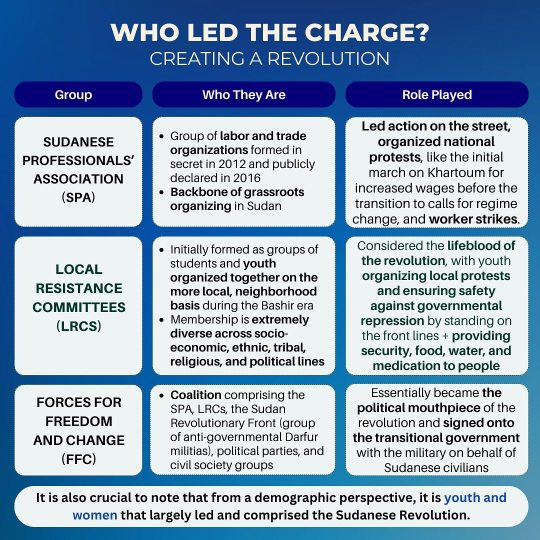
Transcript:
Who led the charge? Creating a revolution
Group: Sudanese Professional's association (SPA)
Who they are:
Group of labor and trade organizations formed in secret in 2012 and publicly declared in 2016
Backbone of grassroots organizing in Sudan
Role played:
Led action on the street, organized national protests, like the initial march on Khartoum for increased wages before the transition to calls for regime change, and worker strikes.
Group: Local Resistance Committees (LRCS)
Who they are:
Initially formed as groups of students and youth organized together on the more local, neighbourhood basis during the Bashir era
Membership is extremely diverse across socio-economic, ethnic, tribal, religious, and political lines
Role played:
Considered the lifeblood of the revolution, with youth organizing local protests and ensuring safety against governmental repression by standing on the front lines + providing security, food, water, and medication to people
Group: Forces for freedom and change (FFC)
Who they are:
Coalition comprising the SPA, LRCS, the Sudan Revolutionary Front (group of anti-governmental Darfur militias), political parties, and civil society groups
Role played:
Essentially became the political mouthpiece of the revolution and signed onto the transitional government with the military on behalf of Sudanese civilians
It is also crucial to note that from a demographic perspective, it is youth and women that largely led and comprised the Sudanese Revolution.
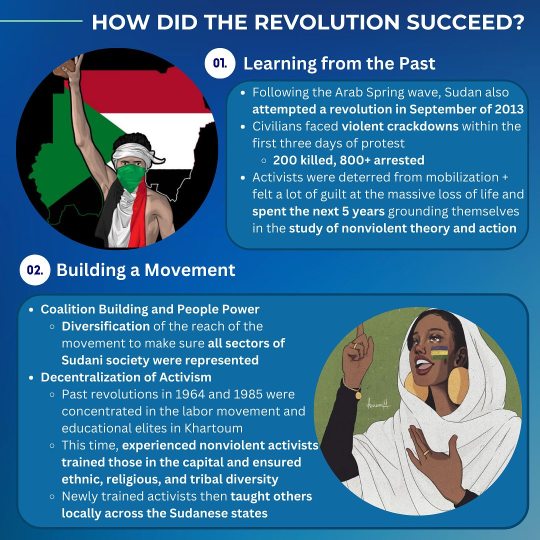
Trabscript:
How did the revolution succeed?
01. Learning from the Past
Following the Arab Spring wave, Sudan also attempted a revolution in September of 2013
Civilians faced violent crackdowns within the first three days of protest. 200 killed, 800+ arrested
Activists were deterred from mobilization + felt a lot of guilt at the massive loss of life and spent the next 5 years grounding themselves in the study of nonviolent theory and action
02. Building a Movement
Coalition Building and People Power
Diversification of the reach of the movement to make sure all sectors of Sudani society were represented
Decentralization of Activism
Past revolutions in 1964 and 1985 were concentrated in the labor movement and educational elites in Khartoum
This time, experienced nonviolent activists trained those in the capital and ensured ethnic, religious, and tribal diversity
Newly trained activists then taught others locally across the Sudanese states
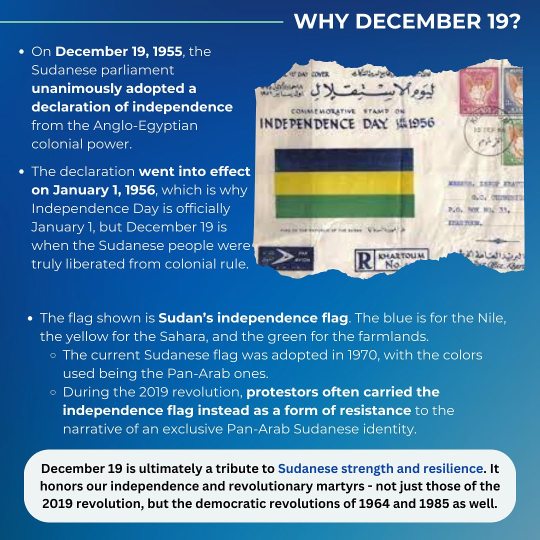
Transcript:
Why december 19?
On December 19, 1955, the Sudanese parliament unanimously adopted a declaration of independence from the Anglo-Egyptian colonial power.
The declaration went into effect on January 1, 1956, which is why Independence Day is officially January 1, but December 19 is when the Sudanese people were truly liberated from colonial rule.
The flag shown is Sudan's independence flag. The blue is for the Nile, the yellow for the Sahara, and the green for the farmlands.
The current Sudanese flag was adopted in 1970, with the colors used being the Pan-Arab ones.
During the 2019 revolution, protestors often carried the independence flag instead as a form of resistance to the narrative of an exclusive Pan-Arab Sudanese identity.
December 19 is ultimately a tribute to Sudanese strength and resilience. It honors our independence and revolutionary martyrs - not just those of the 2019 revolution, but the democratic revolutions of 1964 and 1985 as well.

Transcript:
Why is the revolution ongoing?
The goal was never just the fall of a dictator. The goal was, and is, to build a better Sudan, one free from military rule. One with equal opportunities for everyone, with economic prosperity and safety and security - the key principles of freedom, peace, and justice that the revolution called for.
Today, though, before we rebuild Sudan, before we free it from foreign interests and military rule and sectarianism, we need to save it. Each day that passes by with war waging on is one where more civilians are killed. More people are displaced. More women are raped. More children go hungry. To live in the conflict zones in Sudan right now - whether that be Khartoum, Darfur, Kordofan, or now, Al Gezira, is to be trapped in a never-ending nightmare, a fight for survival. And to live elsewhere in Sudan is to wonder whether you're next.
Sudan Action Week calls on you to educate yourself and others about Sudan, and then to help the Sudanese people save it, because we can no longer do it alone.
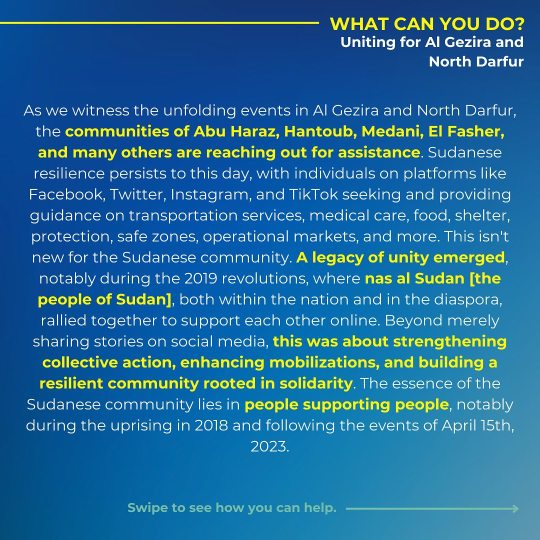
Transcript:
What can you do? Uniting for Al Gezira and North Darfur
As we witness the unfolding events in Al Gezira and North Darfur, the communities of Abu Haraz, Hantoub, Medani, El Fasher, and many others are reaching out for assistance. Sudanese resilience persists to this day, with individuals on platforms like Facebook, Twitter, Instagram, and TikTok seeking and providing guidance on transportation services, medical care, food, shelter, protection, safe zones, operational markets, and more. This isn't new for the Sudanese community. A legacy of unity emerged, notably during the 2019 revolutions, where nas al Sudan [the people of Sudan], both within the nation and in the diaspora, rallied together to support each other online. Beyond merely sharing stories on social media, this was about strengthening collective action, enhancing mobilizations, and building a resilient community rooted in solidarity. The essence of the Sudanese community lies in people supporting people, notably during the uprising in 2018 and following the events of April 15th, 2023
Swipe to see how you can help.
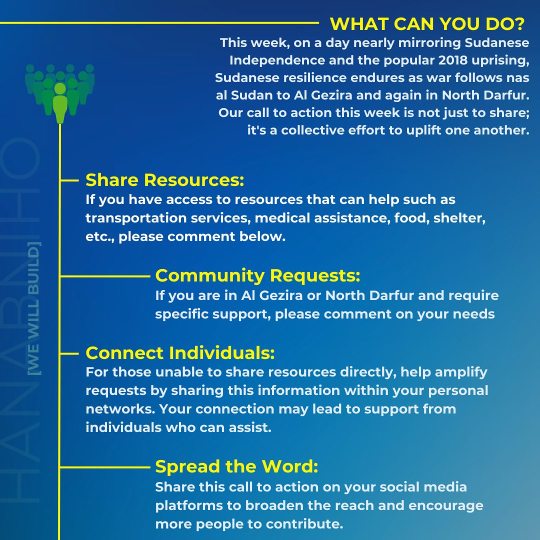
Transcript:
What can you do?
This week, on a day nearly mirroring Sudanese Independence and the popular 2018 uprising, Sudanese resilience endures as war follows nas al Sudan to Al Gezira and again in North Darfur. Our call to action this week is not just to share; it's a collective effort to uplift one another.
Share Resources:
If you have access to resources that can help such as transportation services, medical assistance, food, shelter, etc., please comment below.
Community Requests:
If you are in Al Gezira or North Darfur and require specific support, please comment on your needs
Connect Individuals:
For those unable to share resources directly, help amplify requests by sharing this information within your personal networks. Your connection may lead to support from individuals who can assist.
Spread the Word:
Share this call to action on your social media platforms to broaden the reach and encourage more people to contribute.
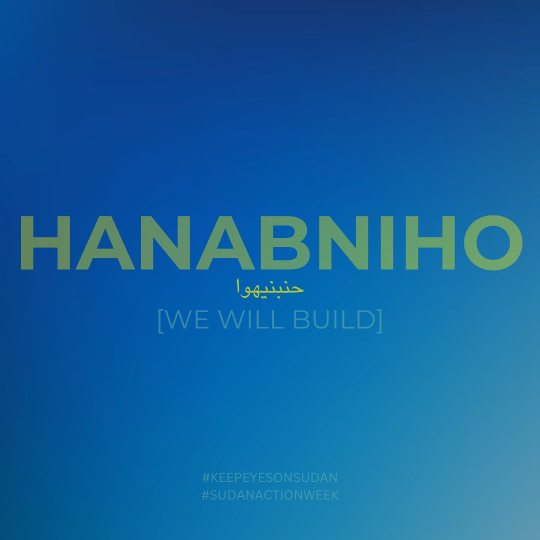
Transcript:
Hanabniho
حنبنيهوا
[We will rebuild]
#keepEyesOnSudan
#SudanActionWeek
923 notes
·
View notes
Text
Warrior Bites: Dietary Needs
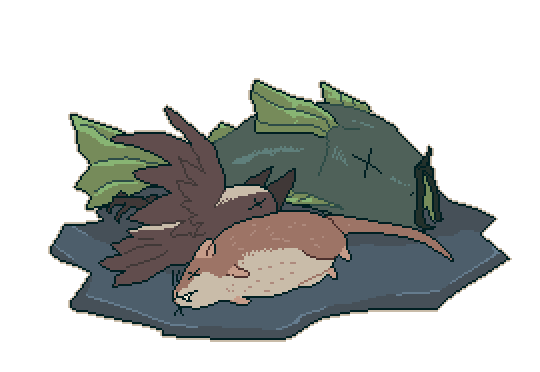
[ID: A fish carcass, bird carcass, and mouse carcass on a stone slab.]
Are you wondering how much prey a Clan needs a day? What they should eat to stay healthy? Why food processing is useful at all? All the answers to these questions and more, contained within a general guide to dietary needs for your Warrior Cats!
As an obligate carnivore, a cat's entire diet revolves around processing meat. More specifically, the ideal diet should be 55% protein, 45% fats, about 1% to 3% carbs, with the remainder being various micro-nutrients. You can expect the average 10-pound warrior to need 350 calories per day, about 3.5 mice on average.
I've also included a section talking about obesity, which dives into how canon's depiction of it is both harmful fatphobia and wouldn't make sense from a cat perspective. It also discusses obesity in realistic cats; and how you're free to choose the realism on that aspect.
Below the cut;
Caloric Intake
Nutrition
Food Processing
On Obesity
Caloric Intake
The general rule for how much a cat needs to eat is that an active, non-neutered tom will need about 35 calories per pound of their own body weight, per day, just to remain the weight they are.
That means that the average warrior, assuming they are 10 pounds, will need 350 calories a day.
Kittens, pregnant and nursing cats, and large warriors will need to eat more than average. Neutered cats, elders, and clerics/medcats will eat less. There are calculators online for determining how much an individual will need, but you can estimate how much an entire Clan will need just by taking 350 and multiplying it by population!
Assuming the average population is about 30 cats, that's 10,500 calories to feed a Clan for a day! To put that in perspective, that many calories would feed 7 large humans. If you felt like fighting a group of angry cats to steal their day's worth of mice, I mean.
Generally speaking, land prey will have a caloric value around 5 calories per gram. Aquatic prey is significantly lower, around 4 calories per gram. Birds will be just below 6 calories per gram. To find out how many cats a piece of prey will feed, or how many pieces a cat will need that day, take the category and multiply by the prey's weight in grams.
So for example, the average house mouse is 20 grams and it is land prey, meaning its caloric value is around 100 calories! A warrior will need 3 and a half mice a day to stay healthy, and a Clan will need 105 mice daily to support 30 cats.
105 mice may seem like a lot, but remember that a wild rabbit is 1,800 grams on average which means 9,000 calories. 2 big pieces of prey will feed the whole Clan, with leftovers.
Those estimates include every part of the animal. Cats eat organs, small bones, and even skin. Skeletal muscle, or "fillets" in reference to fish, is so low in calories that it's typically somewhere between 1 kcal to 1.5 kcal per gram. That's what you're buying in the supermarket; but wild animals don't usually cut their food into choice strips.
(unless you're writing a clan that does food processing of course!)
QUICK FACTS
Average warrior will need 35 calories per pound of weight
10 pound warrior needs 350 calories a day
350 x 30 cats = 10,500 calories to feed a Clan for a single day
Birds provide the most calories per gram, land prey the middlemost, and aquatic prey the least.
Calculate calories in prey by taking the weight, converting to grams, and multiply by 4, 5, or 6 depending on broad category.
If you're having trouble feeding a Clan on small animals, look at bigger prey like rabbits and trout.
Muscle fillets are inferior to organ meats and have a much lower caloric value.
Nutrition
Not all food is the same. The more important thing to consider about any particular meal is NOT its calorie count, but its nutritional value. This is especially important to cats because protein is not stored as fat. If the body has no immediate use for it, it's flushed out.
Since cats should not eat more than 3% carbs, ALL of their fat stores will need to come from fat.
The ideal piece of meat would be at least 55% protein and 45% fat. Every individual species will have a different ratio, and more importantly, individual cuts will have a different ratio.
Skeletal muscle has a higher ratio of protein to fat. Organ meat, also sometimes called "offal," will have a more balanced ratio. That said, nearly all meat skews towards protein. PURE fat is very hard to find on the sorts of animals Clan cats hunt, and must be carefully divided, collected, or processed to make sure all warriors are getting proper nutrition.
I'll be going more in-depth with dietary fat at some other time, as this guide is meant to just be an overview! Just know that some Clans will need to eat MORE food to stay healthy because of this.
Cats need more than the "macronutrients" to stay healthy. They can't JUST rely on the juiciest cuts of meat to keep their health intact, they also need several vitamins and minerals to support their body functions, and avoid getting a deficiency.
Here's some of the important micronutrients, where to get them, and what happens they don't get enough;
Vitamin A: Livers, mealworms, eggs
This is one of the most important micronutrients in a cat's body, used for practically everything. Without this, their coats will grow dull, and their joints stiff, and they'll start to go night-blind. In a severe state, they'll start to lose the ability to heal skin lacerations and die. Pregnant cats and kittens need more of this than usual, but it IS also possible to get vitamin A poisoning from getting too concentrated of a dose.
Calcium: Bones, eggs
With a calcium deficiency, the warrior will feel stiff and sore, and experience painful muscle spasms. Most cats will simply crunch the bones of small prey and never have to worry about this, but if your cats cook or scavenge, they have to be told to NEVER eat the bones of a roasted bird. Because bird bones are hollow and cooking makes them brittle, they can splinter and cause fatal internal bleeding.
Thiamine: Trout, boar meat, mealworms, eggs
Called a Fish Seizure because raw carp and raw bream contains thiaminase, which will destroy thiamine in the body. Lack of thiamine will cause neurological issues, such as the aforementioned seizures, general confusion, memory loss, and muscle weakness. This can be counterracted by eating trout, which is so high in thiamine that there's a theory that carp evolved it specifically to eat salmonids better.
Potassium: Trout, boar meat, mealworms, eggs
As cats get older, they begin needing a lot more potassium for their bodies. It's a very common micronutrient found in most meat, but elders should get the first bite of special snacks "out of respect" which helps keep their potassium level up. Without it, they become very weak.
i feel like that evil struthiomimus from land before time with how many times i typed eggs
QUICK FACTS
The ideal ratio of a cut of meat is 55% protein 45% fat
Organ meat > Muscle meat
Micronutrients are important
But micronutrients can also cause poisoning if, somehow, they're too concentrated
(very hard to come across concentrated micronutrients without the science of chemistry tho. Like if a cat swallowed a vitamin gummy.)
Food Processing
"Food Processing" is when you do something to your food before you eat it. Just a little bit of care is going to go a LONG WAY when it comes to health of the warrior.
Cats that eat raw meat the way canon warriors do are almost guaranteed to get worms. Roundworms, hookworms, and tapeworms are all passed through the infected tissue of rodent prey, and in fish, roundworms, tapeworms, and flukes can pass through raw meat.
All parasites do something a little different, but most digestive worms aren't fatal unless the cat is sick or a kitten. However, nearly ALL of them screw around with digestion, making the cat need to eat more just to stay healthy, or causing stomach irritation. Some of them can even pass in milk, infecting a suckler's nursing kits.
The easiest way to reduce this kind of infection is simply to slice the prey open from mouth-to-butt, Tigerstar-style, and hook and lift out the GI tract before eating. There's nothing in that worth eating raw anyway. It can just be discarded, or cleaned out and used to case tiny sausages! But it's only a reduction; there's still a risk of catching worms from raw meat.
There's also always the possibility of getting salmonella poisoning.
Many believe that cats are immune to this, but that's not true! Carnivores just have a shorter GI tract than omnivores and herbivores, so salmonella spends less time in their gut and ergo has less chance of causing an infection. It still happens, ESPECIALLY when cats hunt songbirds.
Nothing can be done about salmonella in raw meat, besides eating it as quickly as possible. It's innate to the bodies of birds and reptiles, and usually found on raw eggs too.
Some animals are small enough to be dried and carried around as rations, such as minnows or grasshoppers. Others could be sliced up into strips, and marinated in spices like valerian or catmint for an extra boost of energy. It could also be worthwhile to cut the pelt off a particularly soft animal, like a mole, to dry and keep as bedding material.
All of the above examples of food processing are possible without fire, but if your cats DO have fire, they will have a DRASTIC increase to the quality of their health.
Such as;
Cooking will almost completely eliminate those foodborne parasites. Their eggs don't survive extreme heat.
No more salmonella poisoning! GONE! Cooking is the only way to eliminate this!
It can increase caloric absorption from anywhere between 20% to 50%. Our example warrior who needed 3.5 mice a day could suddenly need one less mouse; and even a meager 20% drop in how much the entire Clan needs saves 2,400 calories a day. 24 whole mice!
I HAVE TO STRESS HOW BIG THAT IS. You save anywhere from 2/10 to 5/10 successful kills.
Thiaminase is destroyed by cooking, making bream and carp healthier and reducing "fish seizures."
It allows for fats to be processed and stored as tallow, lard, and oil, so it can be added to other dishes to make them both healthier and tastier.
Most food preservation requires fire in some way; by heating, jellying, boiling, etc. The only other two ways to reliably store food is by having access to a ton of salt, which is hard for most non-coastal clans to acquire, or vinegar, which is so acidic it's a notorious cat-repellent.
While cooking can also destroy some micronutrients, its benefits FAR outweigh any potential "strengths" of raw food. Destroying micronutrients is also not always a bad thing; as TOO MANY micronutrients can cause poisoning. Fire-using Clans will be more likely to "seek" micronutrients than non-fire Clans as a result, though they probably won't recognize the science behind a hankering!
QUICK FACTS
Worms. Basically unavoidable if your cat's eating like a canon warrior.
Some parasites can spread through milk.
Slicing and lifting out the GI tract can significantly reduce the chance of catching worms.
Salmonella can only be eliminated with cooking
Cooking will drastically increase the quality of a Clan's health, if your cats are advanced enough to figure out fire.
Warriors need to hunt a LOT less prey, and can store that prey, if they have fire.
Fire-using Clans will intentionally try to put more types of food in their diets and get 'cravings.'
On Obesity
Warrior Cats is not a realistic series. The boundary that any particular writer draws between humans and warrior cats is completely arbitrary. The series itself follows no sense of realistic genetics, regularly shows the cats using herbs that would poison them, and gives the characters human-centric morals like monogamy and paternal involvement.
So when it comes to being fatness in your project, please keep that in mind. You do not need too follow realistic cat weight distribution, if that's not what your project about. That said, let me tell you about humans vs cats in this department!
Humans have a massive diversity of weight distribution, with varied genetic predispositions to gaining and losing weight. The shame, bullying, and medical discrimination that comes with fatphobia is a LOT more harmful than being fat itself, and the causes of the "obesity crisis" are ridiculously more complicated than "ppl r snorking 2 much food".
Realistic cats aren't the same way.
When REAL cats are fat, that's VERY bad. It's a sign they are being fed the wrong things by humans, or live somewhere that they are able to eat what they shouldn't. They just don't have that same diversity in fat distribution that humans do. Because of how adipose tissue secretes certain hormones, feline obesity is like a chronic inflammatory disease which can cause arthritis, bladder stones, hepatic lipidosis, and more.
But with that in mind, fatness should be perceived very differently even in the most realistic settings. In comparison to humans;
It is harder for a wild cat to put on weight.
Most of what they're eating is raw protein, actively trying to fill the 45% of daily fat intake they need to stay healthy. Protein isn't stored as fat, it's immediately discarded by the body if there is no use for it. A cat would need to be taking an INSANE amount of prey to start becoming dangerously overweight.
Housecats are often fed human food, which has carbohydrates. Low-quality cat food will also use carbs as filler. High carb food is VERY bad for them, since they're only supposed to have 3% carbs at most. This is one of the reasons why it's easy for pet cats to become overweight.
Realistic cats don't look start looking overweight until they are significantly obese.
Most of their fat is stored around their ribs and internally, unlike humans with our thick hips and round bellies, and they are covered in a naturally sagging pelt of fur. It's not as obvious with them. Visually, weight will be noticed best from a bird's eye perspective, unlike humans where it's apparent at every angle.
Putting on the fat that CAN be acquired is ridiculously important
3.5 raw, whole mice a day, per cat, are needed to fill their basic dietary requirements. There are going to be days or months especially during winter where they might be below that number, and that stored fat is going to be lifesaving. Bulking up is actually a big deal!
So not only is how canon treats overweight characters full of malice, it's full of lazy malice. It makes no sense from a realistic standpoint for wild cats to develop an association between fatness and greed or laziness. It's important, hard work for them to acquire it!
Though the Clans are notoriously xenophobic and kittypets are more likely to be overweight, it still doesn't make sense from a realistic cat perspective to be fatphobic in the same way as canon. It's more likely they'd see fat housecats as having "unearned" weight given to them by humans, like they're cheating, or they might be disdainful of how much junk food they eat, or pitiable because it's a sign of a bad twoleg... or just "sour grapes" variety jealousy ☕.
Bottom line is that there's a LOT you can do here which is better than canon's vicious bullying. The writers just lifted British cultural disdain for fat people and put it into the books. They simply did not think it through.
So please do what they didn't, and just put a little extra thought into how your project is going to view fatness! Consider if fatphobia is even a theme you need in your text.
As stated, you do not even have to write weight in your cats as being realistic in this way! I encourage you to pick and choose what's most fun and fitting for your own work. I personally give my characters a more human weight distribution, simply because I want to spite canon and be more body-positive. I am a fat people and you can take Bumble's big chunky bod from my cold, dead hands.
You can choose to make your work however you'd like, and now with this guide, you can have an easy reference for what your cats should eat! Thank you, StarClan, for this prey <3
#Clan culture#warrior cats#Fatphobia#Cw fatphobia#tw fatphobia#Nutrition#Prey#Food#Bonefall's Clan Culture#Food guide#Nutrition guide#Gamer-the-kittypet art#Also if there are any devs or modders out there who wanted to add food values to any games that involve cats#Please feel free to use this guide as all my work is open-source#I can explain how I came to those values and work out some more accurate numbers if you end up needing them#animal death#cw animal death#tw animal death#cw parasites#tw parasites#parasites#Warrior bites
623 notes
·
View notes
Text
We don't have good statistics or estimates for the population size of transmasculine sex workers. Part of that is a lack of data on sex workers in general, but part of it is that trans men are often not visibly trans when they participate in sex work. A lot of the trans men and transmasculine people who sell sex do so under a female persona. The escorting profile of a trans man might be indistinguishable from the profile of a cis woman – intentionally on his part – to attract as many clients as possible. This means that in practice, this segment of the transmasculine population are recorded as cis women.
If we were to assume the population of trans men selling sex was accurately reflected by the profiles visible on escorting sites, we would likely come to the conclusion that trans men are a tiny group within sex work. The reality is that even openly trans men are much more likely to engage in more informal kinds of sex work, such as on apps like Grindr or with people they meet and in social spaces, just like cis gay men who sell sex.
The transmasculine people who claim to be cis women whilst working do share needs with cis women who sell sex, but such resources do not serve all the needs of those hidden trans people. Trans men who are not socially or medically transitioning are driven to sell sex by the same forces which push women to sell sex, with the added pressure of saving money towards transition care and the certainty that they will not be able to sell sex under a female persona forever. Their clientele are also much more likely to shift towards gay and bi men when they do come out, which will change the experiences they have at work and may change their health concerns. [...]
[...] So on what basis do I assume the real numbers are so much higher than the few ads we can find online? The impetus for my initial wondering was prompted by the fact I sold sex for many years before I even came out to myself as trans. And I continued to work under a cis female persona until I had been on testosterone for several months. I’m not arrogant enough to think I’m an exceptional case, so I kept an eye out for others like me.
As I began to speak about my experiences in sex worker group chats, on social media, and in meetings with advocacy organisations, I began to hear from many others in the same situation. Every time I speak up, I hear from more trans men and non-binary people who are hidden. No advocacy group is going to find these people unless they identify themselves this way, and transmasculine people are unlikely to do that when an organisation is explicitly geared towards women.
I’ve heard from more trans men working under female personas than the total number of openly out trans men advertising across all of the escorting sites I use. I’ve never explicitly asked anyone if they have this experience – they’ve all come to me. And with every story I hear there’s a common thread: they want to medically transition, but fear losing their entire income when they do.
Top surgery is a definitive end to being able to work as a cis woman for most, but even testosterone alone can be prohibitive given enough time. By three months on testosterone, clients were beginning to suggest I was a trans woman who’d had genital surgery, and were much more violent with me. This kind of violence rooted in transmisogyny won’t be everyone’s experience, but it happens.
Also, for those interested, check out Jack Parker's Transmasculine Guide to Sex Work
2K notes
·
View notes
Text
Article: 'EA’s BioWare will lay off 50 and cut ties with unionized Keywords playtesting group'
[BioWare Blog post for reference]
Excerpts:
"The layoffs are a blow to morale at the studio and have made the environment difficult, said Gary Mckay, general manager of the developer, in a statement to employees today. He said EA is trying to make BioWare into a more agile and more focused studio. EA has an estimated 12,000 to 13,000 employees, and BioWare had perhaps 250 people.
The moves come with a couple of related or perhaps coincidental events. A spokesperson for EA said that the company was unable to come to an agreement with a part of Keywords, a big game services firm, that provides playtesting services. In June 2022, this small part of Keywords had a group of contractors who voted to unionize.
EA said it was unable to create a new contract and so will let that current one expire on September 27. It’s not clear what will happen to the contractors without the EA contract, but it’s fair to guess that some jobs will likely be lost over at Keywords unless they find other work.
An industry source said EA has renewed work orders with Keywords Studios since their employees voted to unionize in June 2022. But the source added that, in this instance, the two companies simply couldn’t agree to terms. The Keywords contract requirements exceeded what EA/BioWare needed given the change in development approach at the studio.
The layoff also comes about three months after EA moved production of its massively multiplayer online game, Star Wars: The Old Republic, to a third-party publisher, Broadsword, in Reston, Virginia. The game debuted way back in 2011 and has entered maintenance mode. Broadsword has also taken over games like Ultima Online and Dark Age of Camelot so players can keep playing them.
McKay’s leadership will not be affected. Michael Gamble, who recently returned to BioWare, serves as head of the Mass Effect team, and pre-production continues on the next Mass Effect game. Corinne Busche and John Epler, two leaders on Dragon Age, also continue in their roles.
Andrew Wilson, CEO of EA, announced back in March that the company would cut about 6% of its total workforce, and these cutbacks are related to that move.
EA has not said when Dragon Age: Dreadwolf will ship."
[source and full article]
#dragon age: dreadwolf#dragon age 4#the dread wolf rises#da4#dragon age#bioware#mass effect#next mass effect#video games#long post#longpost#sw:tor
617 notes
·
View notes
Note
Just saw your recent reblog, I'm so sorry if you get asked this a lot--is the cut post-game location where Akechi is not a rehab?
Wow, I've just been through my index and it doesn't seem I've ever posted about this—so thank you for asking! Note that this is (hopefully) PART ONE of a two-part post; this is way overlong without me getting into my thoughts about this scene.
The scene we're talking about is a deleted scene where Akechi (offscreen, and clearly alive) is talking to two employees (onscreen), in what looks like a bathhouse. They gossip about his plans for the future, until he arrives in person to catch them out and put some things on record.
Here's the scene, with my translation. (page down for the text). Pay attention to how the, uh, man standing in the bath knows Akechi is outside all along, while the woman who comes in to gossip does not.
youtube
There are a lot of theories about this scene—where is it happening? when does it happen? what purpose does it serve?—not least because there are several different translations floating around. But we can tell quite a bit from the text. Quick summary, since this is a post and a half already:
The place Akechi checks in on 12/24, per this deleted scene, is not a rehab or hotel or hospital, but a type of refuge called a kakekomidera.
This scene takes place (probably) after school on 2/10, as the last of the string of confidant interventions between 2/4 and 2/13. As such, it represents the thing Akechi is doing for Joker to get him out of detention.
Let's take a look.
firstly, what is this place?
People have variously described the bathhouse in this scene as a rehab (no), a hotel or ryokan (no), a hospital (no) and a mental hospital (def Not). So what is it?
The scene tells us exactly what it is:
Gossipy Employee
⋯まあここは、俺らもそうだけど、スネに傷あるモンの駆け込み寺だ。
... maa koko wa, orera mo sou da kedo, sune ni kizu aru mon no kakekomidera da
[lit. well, this place is a kakekomidera for people with a guilty conscience, like us.]
what is a kakekomidera?
A 寺 tera is a Buddhist temple; it's the ji at the end of a lot of temple names. 駆け込む kakekomu means to seek refuge somewhere. So a kakekomidera is a temple where you seek refuge.
And that is the place Akechi has taken himself to: it's a refuge. It's a shelter, like a domestic violence shelter—somewhere you go when you're at the end of your rope, with nowhere to turn; when you're in danger. Somewhere he stayed as a child—with his mother, who was likewise in a perilous and vulnerable situation. Where he knows there are people who will take him in, no questions asked, after everything he's done. Who might even remember him.
Historically, a kakekomidera (like the one in the link) was a place women could go if their husbands were abusive; they entered religious service, and subsequently accessed divorce: "Temple records show that, during the Tokugawa period alone"—that's 1603–1857, often also called the Edo period—"an estimated 2,000 women sought shelter there."
Services called kakekomidera still exist today. They are often in temples—if you can stop by to talk to a monk about your problems and look for solutions, that's a kakekomidera. Online helpdesks are often called kakekomidera—you can look up a "Desktop Publishing kakekomidera" site, for instance.
[more below the cut...]
English sources are usually all referencing the same organisation, Gen Hidemori's Nippon Kakekomidera in Shinjuku:
Gen opens the doors of his organization to all who are in dire straits, regardless of age, gender, income, or social status. Visitors to the office located in Tokyo’s infamous Kabukichō red-light district seek respite from domestic violence, pressing debt, and trouble with organized crime groups. Gen says he even sees gang members looking to make a clean break from the criminal underworld.
Does a kakekomidera do rehab-like things sometimes? Sure. They act as halfway houses for people leaving prison. They help people work through problems in their lives. But in English, a "rehab" is focused on rehabilitating people—after addiction, after illness or injury, after prison, during old age—and that is not what I think we should be picturing here.
I have not been able to track down a residential one like the one in the game, but hey, it's fiction. I wouldn't want to say, though, that they don't exist—don't forget the historical kakekomidera, where you entered service and stayed until you were ready to leave. Though this doesn't appear to be any sort of religious setting, I suspect it's not for nothing that Akechi is doing menial work around the place.
next, when does this scene take place?
The game code allows us to lock this scene almost down to the hour. This will get a little technical at points, so bear with me. You can easily skim past most of this.
Every event in P5 and P5R is numbered. They have two numbers: a major number, identifying the event, and a minor number, identifying part of the event. (You can get more granular than this, identifying individual lines of the script, but that's beyond our scope here.)
This deleted event of Akechi's is numbered E470_810. That is, it has a major number (identifying the event) of 470, and a minor number (identifying part of event 470) of 810.
what is event 470?
Event 470 is the collection of events that happen after Joker enters detention—that is, on 12/24 with Sae in vanilla, or on 2/4 after Maruki's boss fight in Royal.
You can probably see where this is going. Here's the list of events in event 470:
E470_001—[vanilla only] the sad Christmas Day meeting after Joker is arrested, where the PTs determine that this is super unfair and they should do something about it;
E470_101—[vanilla only] Joker's interrogation while detained;
E470_201—Sojiro's intervention after Joker's arrest;
E470_211—Takemi's intervention after Joker's arrest;
E470_301—Kawakami's intervention after Joker's arrest;
E470_311—Iwai's intervention after Joker's arrest;
E470_401—Mishima's intervention after Joker's arrest;
E470_411—Chihaya's intervention after Joker's arrest;
E470_501—Ohya's intervention after Joker's arrest;
E470_511—Yoshida's intervention after Joker's arrest;
E470_601—Shinya's intervention after Joker's arrest;
E470_611—Hifumi's intervention after Joker's arrest;
E470_701—Makoto's intervention after Joker's arrest;
E470_711—Sumire's intervention after Joker's arrest;
E470_810—Akechi's intervention after Joker's arrest.
The next event after that is E471_001, which is Sae meeting Joker in detention for his release on 2/13.
What does this list tell us? Well, mainly, this deleted scene of Akechi's, E470_810, was intended to play along with all those others up there; they're the same event, with the same major number, 470. It's not some random scene we can know nothing about; it has a context, and that context is that Akechi, just like the others, is working to get Joker out of detention. If this scene had been left in, it would have played along with all the other max-rank confidant scenes prior to 2/13.
You might have noticed that Akechi's scene is not quite grouped with the others—there is no E470_801, when the other confidant scenes move cleanly through Ex_x01 to Ex_x11 to Ex_x01 and so on. Whether that's because there's a missing event (storyboarded but never written?) or because he's not quite working with the others, or perhaps because it would have played out of sequence, like Makoto's (numbered last, originally, even though it played first)—we can't tell.
I did say we could lock this scene down almost to the hour, and that brings us to something called the scheduler:
where is event 470 in the scheduler? what is the scheduler?
The scheduler is a piece of code that tells the game engine what events to play on what day. If you want to know what triggers an event to play, the scheduler is a good first stop.
It's split into one file per month (SCHEDULER_04.BF through SCHEDULER_03.BF), and each month is split into a number of functions per day. Usually two functions play in the morning (early and mid-morning?) and five in the PM slot, which we can identify from the events that happen during them:
PM slot A—lunchtime. Includes e.g. the deleted lunch events;
PM slot B—midafternoon. Includes e.g. the chat events during the afternoon lesson;
PM slot C—after school. Includes e.g. Mishima's after-school confidant unlock in your homeroom;
PM slot D—evening. Includes e.g. Sae and Makoto's conversation over dinner before the hot pot party;
PM slot E—bed. Includes e.g. Joker's excursions to the Velvet Room.
In vanilla, the clock is visible for these confidant events, so we can see time passing; the events are also spread more widely through the day. In Royal, though, the clock is disabled for them, probably because they're so much closer together. But whether you consider these event times binding or not, we can still see exactly when they are—because the scheduler tells us so:
Makoto (E470_701)—2/5 (Royal), 1/3 (vanilla), midafternoon;
Sojiro (E470_201)—2/5 (Royal), 1/5 (vanilla), midafternoon;
Takemi (E470_211)—2/6 after school (Royal), 1/7 midafternoon (vanilla);
Kawakami (E470_301)—2/6 (Royal), 1/10 (vanilla), after school;
Iwai (E470_315)—2/7 after school (Royal only);
Iwai (E470_311)—1/13 after school (vanilla only);
Mishima (E470_401)—2/7 (Royal), 1/14 (vanilla), after school;
Chihaya (E470_411)—2/8 (Royal), 1/16 (vanilla), after school;
Ohya (E470_501)—2/8 after school (Royal), 1/18 evening (vanilla);
Yoshida (E470_511)—2/9 after school (Royal), 1/22 midafternoon (vanilla);
Shinya (E470_601)—2/9 (Royal), 1/28 (vanilla), midafternoon;
Hifumi (E470_611)—2/9 (Royal), 1/31 (vanilla), after school;
Sumire (E470_711)—2/10 after school (Royal only).
Lastly, Sae always breaks Joker out during the midafternoon slot on 2/13, in both Royal and vanilla, just before Valentine's Day.
Is there anything notable in this huge swathe of data?
Three confidants changed their event slot in Royal, presumably to fit multiple events into one function on the same day: Takemi moved from midafternoon in vanilla to after school in Royal, Ohya moved from the evening slot to after school, and Yoshida moved from midafternoon to after school.
Iwai has two minor numbers, because he has two slightly different events—vanilla Iwai says "Make sure the guys in lock-up know not to let anyone lay a damn finger on him", while Royal Iwai does not!
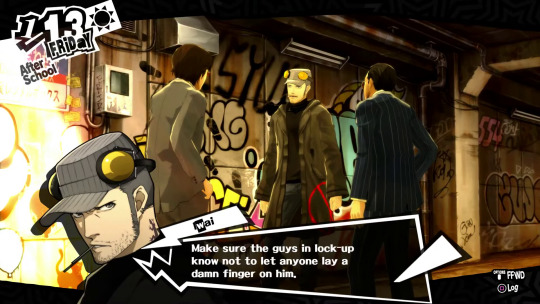
Why was this line cut from Royal? Was Joker somehow in less danger in juvie? Well... vanilla places a lot more emphasis on Joker's detention. Rather than Akechi showing up on 12/24, Sae has a long digression about juvenile hall, and how awful it will be, and the consequences for Joker and his friends. Joker gets interrogated in detention and so on.
So maybe this line was there to build suspense, in vanilla—whereas in Royal, there's just no need, because everything has already happened.
what about akechi
OKAY SO. Getting back to the important stuff, what does all of that tell us about Akechi's deleted scene? Well, it lets us date it.
This scene does not appear to exist in vanilla, when Akechi is pretty definitively ?dead in January and February. It was added with Sumire's, for Royal—and then deleted from the scheduler, so that it's out of game. And in Royal, two events play every day—except on 2/10.
Only Sumire's event plays on 2/10. So we can stake a pretty good guess here that Akechi's event would have been paired with Sumire's event, the other Royal Trio event, in that after school time slot on 2/10.
Maybe it would have played on 2/11 or 2/12. Maybe it would have been like Makoto's event, and jumped out of the list to play elsewhen. But given that it's a reveal, I think it almost certainly would have played last (as its position in the event list suggests)—and 2/10 with Sumire seems like a good place for it.
lastly, what even is this scene
I'm attaching my translation of the scene beneath the cut, since it's been sitting in my Tumblr drafts forever and a day. Obviously this is hugely subject to error and not likely to be entirely correct—nonetheless, enjoy.
* * *
[The Prurient Employee walks in and addresses the Gossipy Employee, who is staring down at the floor.]
Prurient Employee
聞いた?
kiita?
Did you hear the news?
Gossipy Employee
ああ⋯
aa...
I did.
[He turns to her, glancing outside at what appears to be nothing in particular.]
Gossipy Employee
さっき、本人から聞いたよ。
sakki, honnin kara kiita yo
I just got it from him face to face.
Gossipy Employee
来たばっかだってのに、来月で辞めるって話だろう?
kita bakka datte no ni, raigetsu de yameru tte hanashi darou?
People were saying he's leaving next month, right? Even though he only just got here.
Prurient Employee
あの子まだ、ちっちゃかったときよね?お母さんと一緒に出てって何年ぶり⋯?
ano ko mada, chicchakatta toki yo ne? okaasan to issho ni dete tte nannen buri...?
That kid was tiny when he left with his mother, wasn’t he? How many years has it been?…
Prurient Employee
イケメンになって帰ってきた~って、うちら盛り上がってたのに。
ikemen ni natte kaette kita~tte, uchira moriagatteta no ni
We were so excited, he'd just come back all grown-up and handsome, and now...
Gossipy Employee
ここのこと覚えといてくれてたのは嬉しかったよな。
koko no koto oboetoite kureteta no wa ureshikatta yo na
At least he still remembered he could come here, though.
Gossipy Employee
⋯まあここは、俺らもそうだけど、スネに傷あるモンの駆け込み寺だ。
... maa koko wa, orera mo sou da kedo, sune ni kizu aru mon no kakekomidera da
That's what this place is for. To shelter people like us, who have a past they can't forget.
Gossipy Employee
それに昔よしみってんなら、困ってたら匿うのは当然だよ。
sore ni mukashi yoshimi tte n nara, komattetara kakumau no wa touzen da yo
Especially someone we’ve known for so long. As if we wouldn’t hide him when he needed it.
Prurient Employee
『東京でやり残したことがある』って理由らしいわよ。
"toukyou de yarinokoshita koto ga aru" tte riyuu rashii wa yo
I heard he said he has "unfinished business in Tokyo."
Gossipy Employee
そんなことまで知ってるの。
sonna koto made shitteru no
You really do know it all, don't you.
Prurient Employee
⋯ねえ。
...nee
Tell me, though...
Prurient Employee
やり残したことって、やっぱりコレ関係?
yarinokoshita koto tte, yappari kore kankei?
This "unfinished business" of his—that’s what all this is about, right?
[Akechi speaks, offscreen.]
Young Man's Voice
やめてくださいよ。妙な詮索。
yamete kudasai yo. myouna sensaku
I wish you’d keep your nose out of my affairs.
[The Prurient Employee goes !, realising he was there all along.]
Prurient Employee
いるなら言ってよ⋯~
iru nara itte yo...~
Tell me, then, if you're right there!
Gossipy Employee
東京で世話になったヤツがいるんだと。
toukyou de sewa ni natta yatsu ga iru n da to
He did say there was someone who helped him out in Tokyo.
Gossipy Employee
そいつに貸しを作りに行くんだ。
soitsu ni kashi o tsukuri ni iku n da
So he's going back because he owes him.
Gossipy Employee
なあ?
naa?
Right?
Young Man's Voice
借り返して辞めるつもりですから。
karikaeshite yameru tsumori desu kara
Don't worry, I’ll clear my debts here before I leave.
Young Man's Voice
去年の⋯イヴ? アポ無しで来た僕を何も言わず受けれてくれた分と⋯
kyonen no... ibu? aponashi de kita boku o nani mo iwazu ukerete kureta bun to...
For taking me in last year… on Christmas Eve, was it? Without an appointment. Without asking questions.
Young Man's Voice
それと昔、母がお世話になった分はね。
sore to mukashi, haha ga o-sewa ni natta bun wa ne
And for everything you did for my mother.
Prurient Employee
それにしても貸しを作りに⋯なんて、あんたらしいね。
sore ni shite mo kashi o tsukuri ni... nante, anta rashii ne
Never mind that. To go to these lengths just because you owe somebody… No, I guess that’s you all over, isn’t it.
Young Man's Voice
思ったとおりにいけば、あいつとあいつと仲間⋯
omotta toori ni ikeba, aitsu to aitsu to nakama...
If it comes off, then that guy and his friends will live out their lives…
Young Man's Voice
一生、僕に⋯感謝するんです。
issei, boku ni... kansha suru n desu
…Well, they’ll owe me their thanks forever.
[The two employees go ?]
Young Man's Voice
軒先、掃除してきますね。
nokisaki, souji shite kimasu ne
I’m going to sweep up outside.
* * *
revision history
Click here for the latest version.
v1.0 (2023/12/03)—first posted.
259 notes
·
View notes
Text
kia ora! i would like to suggest the coining of a term that would hopefully help a large demographic of mostly-forgotten-about māori to connect with each other and share our experiences to feel less alone, congregate around a concept regardless of country of origin and upbringing, and organise as activists.
i politely ask as many people to spread this as possible to help indigenous people organise with each other and to get the largest amount of interactions possible.
anyway, with all that being said,
i would like to coin the term "ngāti rangiātea" for māori who do not know their iwi to use.
this is based on the well known whakataukī/proverb, "i will never be lost, for i am a seed which was sown from rangiātea." i chose this whakataukī due to the spiritual significance of rangiātea as a place in māori culture, as well as to emphasise that no matter how it feels, we are not lost, we can find ourselves in each other, we can experience strength and self-realisation, and that we will exist with mana and without whakamā as rightful tangata whenua.
i've put my reasoning, personal experiences shaping my viewpoints on the matter, and various statistics under the cut to make this post reblog-friendly and i would suggest fellow māori read it regardless of whether or not they know their iwi. i also ask for the opinions of other māori, ESPECIALLY AND SPECIFICALLY other māori who do not know their iwi. in fact, i politely ask māori to share this with their whānau and people in general to share this with māori they know, especially any they know who do not know their iwi. a wide reach is what i am going for to get the largest amount of voices, critiques, and opinions on the topic and to avoid this from just becoming a very small thing that stays in an online echo-chamber.
to begin, the 2018 aotearoan census shows that, of the 775,836 people identifying as māori in aotearoa, roughly 17% are unable to identify their iwi in the census. this has gone up by 1% since 2006, showing that we are a considerably stable percentage of people. along with this, there are more than 170,000 māori living in australia and, while there are no solid statistics, there are an estimated 8,000 māori living in the UK, 3,500 in the US, 2,500 in canada, and 8,000 in other countries where there's no option for māori or any polynesians on the census.
this number adds up to 967,816 total māori and while there's no census in these countries asking for your iwi, i would go as far as to assume that there's a larger number of diaspora māori who are no longer able to identify their iwi than there are in aotearoa. of course, this is just speculation based on my lived experiences and conversations with other diaspora māori, however even assuming that it's the exact same amount globally, 17%, this is roughly 164,532 māori worldwide who do not know their iwi. nearly one in five māori do not know their iwi.
regardless of the specific statistics, the hard fact here is that there is a large percentage of māori who are unsure of their iwi for whatever reason. it's extremely easy to feel unsure of yourself, lost, disconnected, and uncomfortable speaking on issues regarding te ao māori when you're unsure of your iwi (or your hapū, whānau, waka, or anything else, but there is heavy emphasis on the iwi) and it's very easy for whakamā to take hold, especially when many māori who can recite their whakapapa aren't very polite or understanding about your situation to say the least.
and there are a lot of those people.
unfortunately, i've spoken to many māori who are of the opinion that not knowing your iwi due to colonialism, assimilation, forced disconnection, etc. means that you should not, cannot, call yourself māori. this is a disgusting viewpoint to have and in my opinion it spits on the fundamental concepts of māori culture and worldviews. thankfully this is a small yet vocal group of people, but even so, they add to the collective experience that makes it extremely difficult to navigate a world while full of whakamā and internalised racism. it can feel like there's no space for you, no term you can use, nobody you can relate to, no mana you can claim, nothing. when you cannot recite your whakapapa, it can feel like there's a part of you that's fundamentally missing.
as well as this, even when people mean well, when you are in this situation, you're usually told to just do some genealogy work, do some research, ask your family what they know. sometimes, these steps are simply not possible. other times, we've already done everything suggested over and over and over again. we're generally told "oh, that sucks, but one day you'll find out, keep looking!" in response to our lack of iwi. sure, they mean well, but i have never once been told anything along the lines of "that's okay, some things are lost to time through no fault of your own. don't beat yourself up over something your whānau had to hide to survive, what you do now to uphold your family's mana, what you do know about your whānau, and who you ultimately become is more important than what you no longer know."
and why? why is it seen as shameful to say matter-of-factly that i don't know my iwi? i'm not looking for comfort, i'm not looking to be told that, aww, there there, i'll find it eventually. i'm stating a fact. i do not need pity, i need my mana and voice to be respected.
this concept is what i want to emphasise by coining ngāti rangiātea. some things are lost to time, but we aren't. our loss of knowledge does not mean that we are unworthy of being māori, that we are unworthy of basic human respect. it does not mean that we have lost everything that our whānau knows. it is a scar, a reminder of what colonisation took from us, yes, but we cannot allow it to continue to be an open bleeding wound. we will not be lost to time and we should not bow our heads and act like we do not exist, that we're inconvenient, that we damage the "image" that māori have. in fact, we are an important aspect of māori culture and ignoring our existence does harm to everybody.
and of course we can't speak on some topics regarding te ao māori. this seems to be a topic that comes up frequently as a strawman. yes, there are some topics that would be irresponsible to speak on when we have no experience with them. this doesn't mean we can't speak on anything. having a collective identity, an "iwi" to congregate around even just politically, would help us speak on topics that we are more qualified to speak on than māori with knowledge of their iwi (yes, those topics exist, shockingly.)
we will never be lost, for we are a seed sown in rangiātea.
by identifying as ngāti rangiātea, i wish to emphasise that it's important to accept that sometimes, someone just won't be able to find every piece of information. loss of family knowledge is literally one of the primary goals of forced assimilation! we all went through it as colonised peoples, why must we continue to attach shame to those of us who were forced to obfuscate our history to keep our children alive? it's not a personal flaw, it's not a dirty secret, it's a fact of life that must not continue to be kept quiet out of shame, and the sooner we can focus on healing this subsection of our community, the stronger māori as a whole will become.
so, this is why i'd like to coin a term for māori who are unsure of their iwi. this is what i intend to achieve by giving us a name, our own "iwi" to congregate around, to identify ourselves as. instead of hanging my head and saying "i'm not sure what my iwi is, i'm sorry", instead of feeling inclined to beg like a dog to be treated with respect, i would like to look people in the eye and tell them that i am ngāti rangiātea. i would like this label to be synonymous with strength and not shame, that i refuse to let my whakamā swallow me, that i am just as worthy of calling myself māori as anyone else, that there are many others in my iwi (or lack thereof). i would like other people to have that as well and i would like those like me to feel less lost when all they've been told is "well, you'll learn your iwi eventually!" as if that's going to help someone feel better if they can't find their iwi.
and even if a person finds their iwi eventually, it's absolutely disgraceful that people are treated that they're not allowed to access many basic parts of te ao māori until they discover something they are not even 100% destined to find. i think that this view contributes to a lot of people who eventually find their iwi becoming unnecessarily arrogant towards those who truly cannot find this information, that they're just not putting enough effort in. if a person finds their iwi after identifying as ngāti rangiātea, they are fully welcome to continue to identify as this political label along with the iwi they now know they belong to as i wish for it to be a term that describes your experiences, your upbringing, and your community. you don't suddenly lose your whānau or your lived experience when you discover your whakapapa.
finally, this hopefully goes without saying, but ngāti rangiātea is not meant to function as a real existing iwi does. the term will hopefully be used as a way to identify yourself and other people and organise but i don't expect nor do i want this to be treated like a coordinated iwi. i expect and hope for this to be a decentralised way of identifying and experiencing community to make it easier to organise as a people. think of this the way the terms ngāti kangaru, ngāti rānara, ngāti tūmatauenga etc. are used.
-----
so, the tl;dr is that i feel like coining a name for a phenomenon that nearly one in five of all māori experience in quiet shame, to make it easier for us to congregate and find each other, speak on our experiences, organise as activists, feel less lost, and ultimately give us the ability to regain our mana as a community with shared goals and experiences. i have spoken to many māori who feel this way and my suggestion for this term is ngāti rangiātea, to show homage to the well known whakataukī, "i will never be lost, for i am a seed sown from rangiātea", to give us a community to work with, and to give us an "iwi" to list when asked instead of fumbling for words and feeling whakamā.
i would like to take the emphasis off of constantly looking to the future for what you may or may not even find with this identity. we are not broken, we are not lost, for we are seeds sown in ngāti rangiātea.
tēnā koutou, tēnā koutou, tēnā tatou katoa, and if you got this far, thank you for reading.
#maori#māori#pasifika#indigenous#indigenous issues#polynesia#aotearoa#aotearoa new zealand#new zealand#tangata whenua#new zealand politics#politics#i was considering calling it smth along the lines of ngāti whāngai to represent that we would be whānau from different paths and family#but ngāti rangiātea felt more succinct and meaningful. particularly with how it's very easy to feel lost when you're unsure of your iwi#please boost this even if you're not māori as i'd like as many people to see as possible <3#anyway i'm quite nervous and i hope this doesn't come across like i'm trying to be any kind of authority haha#i just feel like this is an extremely important topic that affects many people but is rarely spoken about for various reasons#ngāti rangiātea
363 notes
·
View notes
Text
I have a trolley problem for you all.
You have to let one of the two following groups die. There is no cute gif editing to save them both, there is no “I’ll just stop the trolley.” The trolley will run in spite of your protestations.
One group has approximately 70,000 people.
One group has approximately two billion people.
Which one is dying?
Now: does your answer change if I say the first group is Palestinians and the second group is “all of Eastern Europe, most of the US statistically including you, a significant portion of Mexico, a significantly larger number of Palestinians, North Korea, a large chunk of China, and hundreds of thousands worldwide due to increasing pollution and climate change and Trump pulling us back out of the Paris Accords”?
If it does, you need a cult deprogrammer.
The top number is my estimate for maximum civilian loss in Gaza with Biden in office. It’s a tragic number, about 70,000 too many. But we’ve already seen he’s losing patience, and if you read some Israeli media instead of getting all your news off TikTok, you’ll discover it’s pretty well-known he’s putting A LOT of pressure on Netanyahu right now. Ol’ Benny has put himself in a no-win situation, which is what happens when you try to become a dictator. The loss is horrible, but it is the lesser of two losses.
The bottom number is based on promises Trump and the Republican Party have made, which Biden is currently keeping at bay. I should note that number does NOT include the possibility of a nuclear exchange between China and the US, which would bump it up to “well, after all the initial deaths and the second wave of cancer deaths and the disease and starvation that inevitably follow, there might be two billion people left.”
I need you to think very hard about this. We aren’t just voting for the future of the country, we’re voting for the future of the world.
This isn’t about feel-good online “activism” that doesn’t really do anything. It is about REAL LIVES.
Act like it.
116 notes
·
View notes
Text
A Toronto-area real estate agent has had his business suspended by the franchise that runs it after a social media post about the Israel-Hamas conflict drew swift and sharp criticism.
A screenshot posted online appears to show a Re/Max agent mocking destroyed buildings and rubble in the Gaza Strip.
The Gaza Strip has been pounded by Israeli airstrikes since Hamas — listed as a terror group by the Canadian government — launched a brutal attack on Israel from the area on Oct. 7.
The Hamas attack left more than 1,400 Israelis dead and led to a declaration of war by Prime Minister Benjamin Netanyahu. In the days after the attack, Israel also cut electricity, water and food supplies to Gaza and its residents. The Gaza Health Ministry said 3,478 people have been killed in Gaza since the war began, and more than 12,000 wounded.
“Coming to the market,” a social media post from an account named Vadim Vilensky said, with two laughing emojis. [...]
Continue Reading.
Note from the poster @el-shab-hussein: According to estimates, around 6500 Palestinians in Ghazzah are believed to be trapped under the rubble of their buildings right now, and are not being counted in the current death count because of the inability to confirm their deaths. Here is this realtor posting that rubble, beneath which are trapped dead and still dying bodies of people, and making a joke about it.
Tagging: @politicsofcanada
166 notes
·
View notes
Text
Daily update post:
There are so many funerals taking place in Israel, they have to be queued up and the amount of time each family has to bury their loved one/s has to be limited.
Israel officially said it estimates about half of those who are considered kidnapped by Hamas are probably not alive. They were either taken as bodies to be used as blackmail material, or they died on their way to or in Gaza from their wounds.
The most northern Israeli town, Metula, has been declared closed military territory due to Hezbollah's firing at Israel.
Hamas has declared a 'day of rage' and asked for its supporters to attack Jews everywhere. Many Jewish schools and institutions have decided to remain closed today to be on the safe side.
In Beijing, an Israeli diplomat was stabbed, this is believed (but still not confirmed) to be a terrorist attack.
Bruna was a Jew from Brazil and only had a mom and a sister in Israel. According to Jewish tradition, there should be a minyan (a group of 10 Jewish men) to pray for the dead at a funeral, so the family posted online, asking for 10 Jewish men to come. Ten thousand Israelis showed up for the funeral.
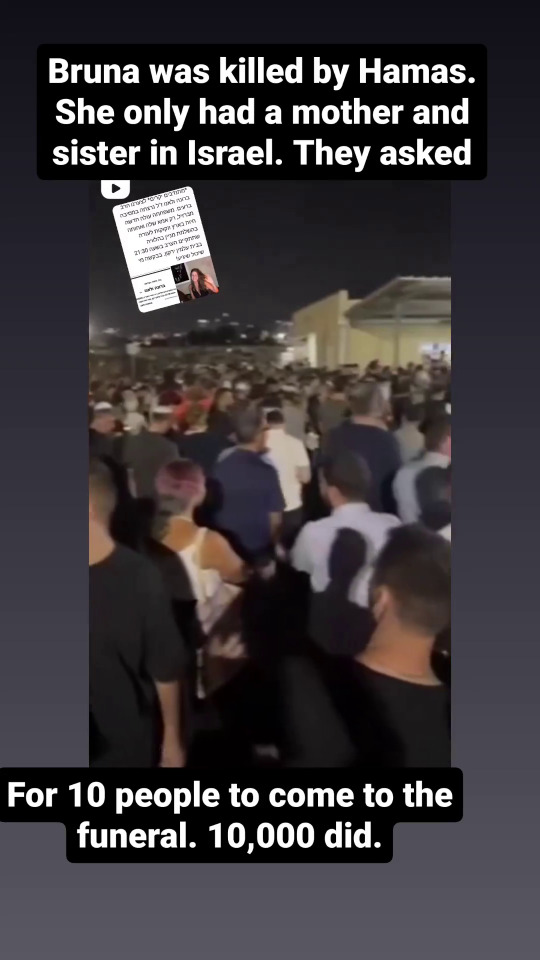
Another personal story of a murdered Israeli:

May his memory be a blessing!
Another.
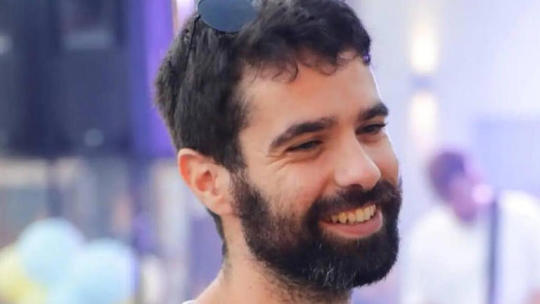
Sagi Golan was about to marry his boyfriend, Omer Ohana, in 8 days. When Hamas attacked, he didn't wait for the army to call him for reserves duty. He took the initiative, drove down to the south and led a team to fight the terrorists. He was killed by them. At his wedding, Sagi and Omer's wedding song was supposed to be Zachiti Le'ehov (I Was Privileged to Love) by openly gay singer Ivri Lider. Ivri sang this song at Sagi's funeral.
On a personal note, every Israeli has a list that keeps getting longer of who they know that's been affected by Hamas' attack on Israel. This is mine.
(for all of my updates and ask replies regarding Israel, click here)
#israel#israeli#israel under fire#israel under attack#israel news#israelunderattack#personal#antisemitism#judaism#jews#jew#jewish#terrorism#anti terrorism#antisemites#antisemitic#hamas
163 notes
·
View notes
Text
TW: Trans activists
For more than a decade now, trans activists have been harassing those who belong to a feminist philosphy we call radical feminism or the women’s liberation movement.

Radical feminists, like most feminists, believe that men use sex to oppress women. Meaning they oppress women through sexual exploitation and by perpetuating sexist discrimination towards those who belong to the female sex. They were the first to research and expose violence against women as endemic and traumatizing, and to create shelters for rape and domestic violence victims. Those shelters are now being vandalized and defunded by trans activists.

Because radical feminists don’t believe in gender identities, gendered souls, gender roles or any form of innate personality based on sexist stereotypes, they have been receiving rape and death threats on a daily basis. The acronym “terf” was soon invented and is now used to describe any person who doesn’t support the trans movement, even if they’re not feminists, just as long as they're women, though lesbians and feminists tend to be the primary targets.

As a whole, the trans movement claims that its biggest enemy and threat, its most pressing matter, its most dangerous opponent is the women’s liberation movement or what they call “radfems” or “terfs”. This is where their energy and anger is directed, typically in the form of sexist and sexual harassment, intimidation techniques, violence, censorship and social isolation. So let’s talk about that.
From the book Hate Crimes in Cyberspace:
Cyber harassment involves threats of violence, privacy invasions, reputation-harming lies, calls for strangers to physically harm victims, and technological attacks.


Victims’ in-boxes are inundated with threatening e-mails. Their employers receive anonymous e-mails accusing them of misdeeds. Even if some abuse is taken down from a site, it quickly reappears on others. Victims’ sites are forced offline with distributed-denial-of-service attacks.

While some attackers confine abuse to networked technologies, others use all available tools to harass victims, including real-space contact. Offline harassment or stalking often includes abusive phone calls, vandalism, threatening mail, and physical assault.
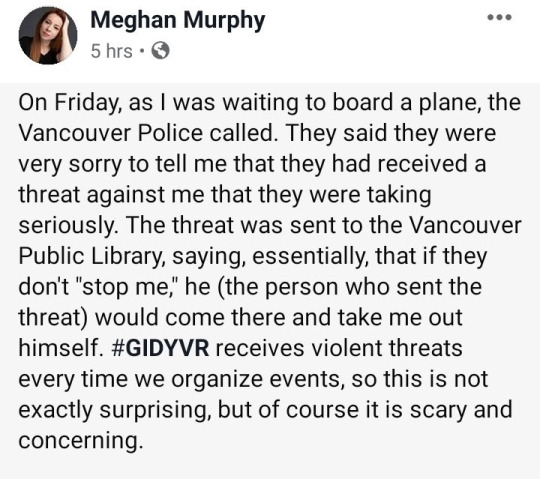
The Internet extends the life of destructive posts. Harassing letters are eventually thrown away, and memories fade in time. The web, however, can make it impossible to forget about malicious posts. And posts that go viral attract hundreds of thousands of readers.
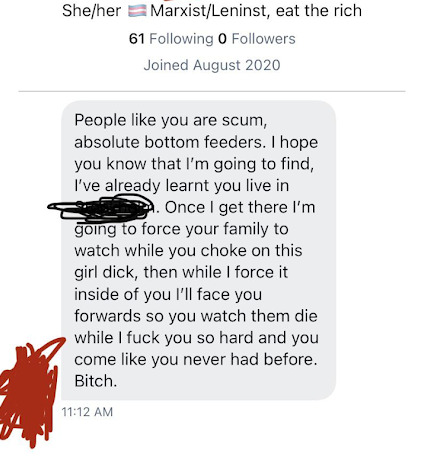
Online harassment can quickly become a team sport, with posters trying to outdo each other. Posters compete to be the most offensive, the most abusive. An accurate name for such online groups is cyber mobs. The term captures both the destructive potential of online groups and the shaming dynamic at the heart of the abuse.

Cyber harassment disproportionately impacts women. The U.S. National Violence Against Women Survey reports that 60 percent of cyber stalking victims are women, and the National Center for Victims of Crimes estimates that the rate is 70 percent. Of the 3,393 individuals reporting cyber harass-ment to WHOA from 2000 to 2011, 72.5 percent were female. The most recent Bureau of Justice Statistics report found that 74 percent of individuals who were stalked on or offline were female, and 26 percent were male.

Researchers found that users with female names received on average one hundred “malicious private messages,” which the study defined as “sexually explicit or threatening language,” for every four received by male users.

According to the study, “Male human users specifically targeted female users.” By contrast, men are more often attacked for their ideas and actions. John Scalzi, a science fiction author and popular blogger, has found online invective typically situational. When he writes something that annoys people, they tell him so. People do not make a “hobby” out of attacking his appearance and existence as they do female bloggers.

The nature of the attacks similarly attests to bigotry’s presence. Hate expresses something uniquely damaging. It labels members of a group as inhuman “others” who do not possess equal worth. It says that group members are inferior and damaged. Bigotry conveys the message that group members are objects that can be destroyed because they have no shared humanity to consider.
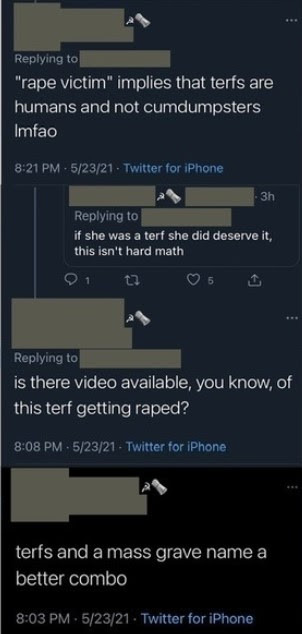
Cyber harassment exploits these features by exposing victims’ sexuality in humiliating ways. Victims are equated with their sexual organs, often described as diseased.


Once cyber harassment victims are sexually exposed, posters penetrate them virtually with messages that say “I will fuck your ass to death you filthy fucking whore, your only worth on this planet is as a warm hole to stick my cock in.”
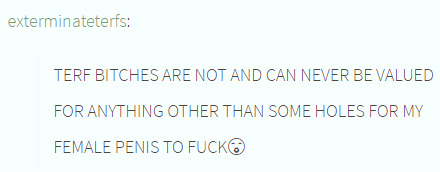

Rape threats profoundly impact women: over 86 percent of rape victims are female. Virtual elimination may follow the imagined penetration: “First I’ll rape you, then I’ll kill you.”

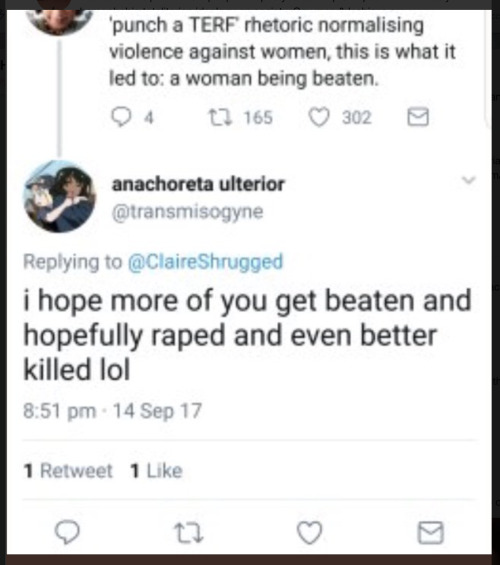
One woman who faced online abuse noted, “Someone who writes ‘You’re just a cunt’ is not trying to convince me of anything but my own worthlessness.”
Despite the gravity of their predicaments, cyber harassment victims are often told that nothing can or should be done about online abuse. Journalists, bloggers, lay observers, and law enforcement officials urge them to ignore it. Victims are called “whiny baby girl[s]” who are overreacting to “a few text messages.” Often victims are blamed for the abuse. They are scolded for sharing their nude images with loved ones or for blogging about controversial topics. They are told that they could have avoided the abuse had they been more careful.

A related message sent to victims is that the benefits of online opportunities are available only to those who are willing to face the Internet’s risks. They are advised not to expect anything different if they want to make a name for themselves online. The choice is theirs: they can toughen up or go offline.
The Internet is governed by society’s rules. Life online bleeds into life offline and vice versa. The notion that more aggression should be tolerated in cyberspace than in real space presumes that virtual spaces are cordoned off from physical ones.
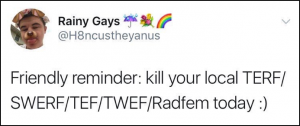
Most victims do not report cyber harassment to the police because they assume that nothing will be done about it. Sadly, they are right. Law enforcement frequently fails to act on victims’ complaints even though criminal law would punish some of the behavior. Victims are told to turn off their computers because “boys will be boys.”
Online harassment victims are told that nothing can be done; they are advised to ignore rape and death threats. During the
summer of 2013, high-profile women were subjected to a torrent of online threats. The feminist activist Caroline Criado Perez received hundreds of graphic rape threats via Twitter after her successful campaign to feature more female images on British banknotes.

Members of Parliament and female writers who publicly supported Criado-Perez faced the same, including bomb threats. One tweet featured a picture of a masked man holding a knife with the message, “I’m gonna be the first thing u see when u wake up.”

Because the Internet serves as people’s workspaces, professional networks, résumés, social clubs, and zones of public conversation, it deserves the same protection as offline speech. No more, no less.

Without doubt, the free speech interests at stake are weighty. Free expression is crucial to our ability to govern ourselves, to express our thoughts, and to discover truths. For that reason, government cannot censor ideas because society finds them offensive. Truthful speech must not be banned just because it makes people uncomfortable.

But credible threats, certain defamatory falsehoods, social security numbers, and nude images posted without consent contribute little to discourse essential for citizens to govern themselves and discover truths. Their net effect is the silencing of victims. Victims could blog, post videos, and engage on social networks without fear of destructive cyber harassment. They could raise money using networked tools unencumbered by rape threats, reputation-harming lies, and distributed- denial- of- service attacks. They could take advantage of all of the expressive opportunities available online. Protecting against online harassment would secure the necessary preconditions for victims’ free expression.

With the help of law and the voluntary efforts of Internet intermediaries, parents, and teachers, we might someday achieve a free and equal Internet. We need to take action before cyber harassment becomes a normal feature of online interactions. A hostile online environment is neither inevitable nor desirable. We should not squander this chance to combat discriminatory online abuse; it is early enough in our use of networked tools to introduce equality of opportunity as a baseline norm of interaction.

260 notes
·
View notes
Note
I would never defend them - at least not the ones who actually harass people - but I do wonder if there's some antis out there who genuinely come from good intentions.
Super serious and genuinely shameful confession: I'm an ex-radfem. I went into those circles in the first place bc I liked some of Dworkin's works. And while I obviously do not recommend anyone ever get into radical feminism, I will say this: If haven’t been down that very specific rabbit hole of ideology yourself - especially in online settings - you cannot even begin to imagine how fucking INSANELY pervasive the ideas are. Even if you've been a victim of radfem hate, if you haven't been a radfem yourself, I'm truly inclined to think you have no idea what those spaces are actually like. Sorta like how if you've been a victim of fundie hate, that is awful and it fucking sucks, but if you haven't been raised fundie yourself, you really don't know what it's like to be IN those circles, just a VICTIM of those circles.
I hate to throw around words like “hivemind” or “groupthink” but it is that. I went into radfem spaces thinking that I was above believing certain things that they believed but I clearly wasnt, it is so fucking toxic and that’s why i’ll never believe that “TIRF” (trans inclusionary radfem - something I tried and failed to be) can be a real thing. And then these same people have the audacity to call trans rights a cult, but you know, it's whatever.
Obviously terfs are more serious in the "real world" than antis are, but there are some parallels in the way that both groups feel about kink/porn discourse. (No, I'm not saying that antis "believe TERF ideology" or anything, but I do think in the specific context of sex stuff, there ARE alot of parallels.)
I am not defending radfems either, but I will say that I got into it because I was genuinely worried about things such as: PH and how they just steal content from sex workers, the abuse going on in the sex work industry, the phenomenon of young girls who are waiting to turn 18 so they can start an OF account, romance novels that were not marketed as dark but should've been considering they straight up romanticized abuse and rape.
I really do think that most antis are of a similar mindset -- people, typically young traumatized people (not trying to pull the neurodivergent minor card, it's just that statistically speaking, that label CAN describe most antis) who are truly worried that, like, idk, some young girl is gonna watch Twilight or read Reylo fic and think that an overly possessive bf is #goals. Again, I'm NOT trying to defend this ideology or line of thinking at all, I'm just saying that i DO think most of them really don't realize the harm that they're doing, and actually think they're doing good.
I actually kinda feel bad for them, but like my earlier comparisons, I feel bad for them in the same way I feel bad for fundies or evangelicals. I feel bad that they hold such an awful ideology while thinking they're doing good things, but I stop feeling bad once they start ACTUALLY hurting people and I'll always feel worse for the people who they harass and harm.
And like I'd never want to be a radfem again and I hate that I was one once but, between myself and your ~10k (ballpark estimate lol) followers, I think that my time spend in that belief system gave me some really good insight to cult mindsets, which was something I didn't understand before or have much sympathy towards, and I've emerged with a lot of empathy for people who ARE stuck in bad ideologies. I could've been born into a hate group. I could've been preyed on by alt-right people and sucked in that way. Instead, it was reading radblr during quarantine that got me. Before I fell into it, I just mindlessly hated everyone in that group, and now I just feel sorry for them (still without justifying any of their actions).
It's honestly a really, really, complicated thing to try to grapple with. Anyone, yes including you reading this, can be brainwashed into hate. The second you think you're too good for that, you've lost.
This was more of a vent than a discourse ask. I guess my tl;dr is: I hate antis, terfs, fundamentalists, etc, as much as the next guy, but I also recognize that some of those people truly truly do think they're on the right side of history, and some of those people have been sucked into an ideology they never would've believed otherwise if not for xyz factors. While hate groups will never deserve pity, there are some vulnerable people in hate groups who for some reason believe they're doing good, and I wish I could help all of those people.
--
Yeah, I assume many antis are perfectly sincere in their desire to protect people. They're just wrong about what will work.
76 notes
·
View notes
Text
Where It’s Most Dangerous to Be Black in America
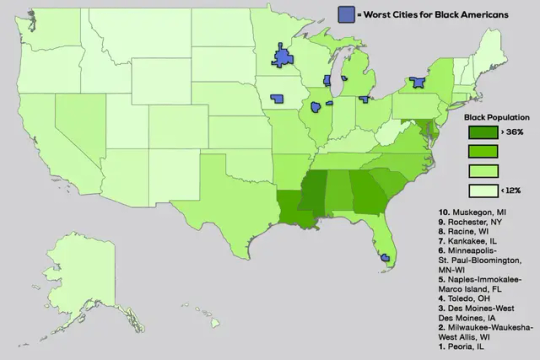
Black Americans made up 13.6% of the US population in 2022 and 54.1% of the victims of murder and non-negligent manslaughter, aka homicide. That works out, according to Centers for Disease Control and Prevention data, to a homicide rate of 29.8 per 100,000 Black Americans and four per 100,000 of everybody else.(1)
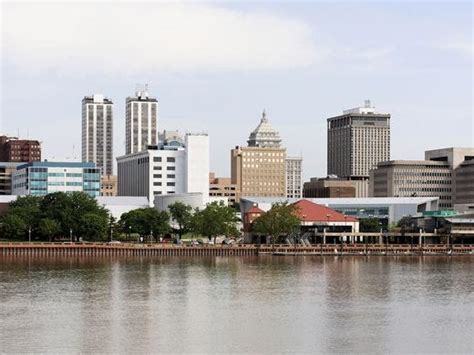
A homicide rate of four per 100,000 is still quite high by wealthy-nation standards. The most up-to-date statistics available from the Organization for Economic Cooperation and Development show a homicide of rate one per 100,000 in Canada as of 2019, 0.8 in Australia (2021), 0.4 in France (2017) and Germany (2020), 0.3 in the UK (2020) and 0.2 in Japan (2020).
But 29.8 per 100,000 is appalling, similar to or higher than the homicide rates of notoriously dangerous Brazil, Colombia and Mexico. It also represents a sharp increase from the early and mid-2010s, when the Black homicide rate in the US hit new (post-1968) lows and so did the gap between it and the rate for everybody else. When the homicide rate goes up, Black Americans suffer disproportionately. When it falls, as it did last year and appears to be doing again this year, it is mostly Black lives that are saved.
As hinted in the chart, racial definitions have changed a bit lately; the US Census Bureau and other government statistics agencies have become more open to classifying Americans as multiracial. The statistics cited in the first paragraph of this column are for those counted as Black or African American only. An additional 1.4% of the US population was Black and one or more other race in 2022, according to the Census Bureau, but the CDC Wonder (for “Wide-ranging Online Data for Epidemiologic Research”) databases from which most of the statistics in this column are drawn don’t provide population estimates or calculate mortality rates for this group. My estimate is that its homicide rate in 2022 was about six per 100,000.
A more detailed breakdown by race, ethnicity and gender reveals that Asian Americans had by far the lowest homicide rate in 2022, 1.6, which didn’t rise during the pandemic, that Hispanic Americans had similar homicide rates to the nation as a whole and that men were more than four times likelier than women to die by homicide in 2022. The biggest standout remained the homicide rate for Black Americans.

Black people are also more likely to be victims of other violent crime, although the differential is smaller than with homicides. In the 2021 National Crime Victimization Survey from the Bureau of Justice Statistics (the 2022 edition will be out soon), the rate of violent crime victimization was 18.5 per 1,000 Black Americans, 16.1 for Whites, 15.9 for Hispanics and 9.9 for Asians, Native Hawaiians and other Pacific Islanders. Understandably, Black Americans are more concerned about crime than others, with 81% telling Pew Research Center pollsters before the 2022 midterm elections that violent crime was a “very important” issue, compared with 65% of Hispanics and 56% of Whites.
These disparities mainly involve communities caught in cycles of violence, not external predators. Of the killers of Black Americans in 2020 whose race was known, 89.4% were Black, according to the FBI. That doesn’t make those deaths any less of a tragedy or public health emergency. Homicide is seventh on the CDC’s list of the 15 leading causes of death among Black Americans, while for other Americans it’s nowhere near the top 15. For Black men ages 15 to 39, the highest-risk group, it’s usually No. 1, although in 2022 the rise in accidental drug overdoses appears to have pushed accidents just past it. For other young men, it’s a distant third behind accidents and suicides.
To be clear, I do not have a solution for this awful problem, or even much of an explanation. But the CDC statistics make clear that sky-high Black homicide rates are not inevitable. They were much lower just a few years ago, for one thing, and they’re far lower in some parts of the US than in others. Here are the overall 2022 homicide rates for the country’s 30 most populous metropolitan areas.
Metropolitan areas are agglomerations of counties by which economic and demographic data are frequently reported, but seldom crime statistics because the patchwork of different law enforcement agencies in each metro area makes it so hard. Even the CDC, which gets its mortality data from state health departments, doesn’t make it easy, which is why I stopped at 30 metro areas.(2)
Sorting the data this way does obscure one key fact about homicide rates: They tend to be much higher in the main city of a metro area than in the surrounding suburbs.
But looking at homicides by metro area allows for more informative comparisons across regions than city crime statistics do, given that cities vary in how much territory they cover and how well they reflect an area’s demographic makeup. Because the CDC suppresses mortality data for privacy reasons whenever there are fewer than 10 deaths to report, large metro areas are good vehicles for looking at racial disparities. Here are the 30 largest metro areas, ranked by the gap between the homicide rates for Black residents and for everybody else.
The biggest gap by far is in metropolitan St. Louis, which also has the highest overall homicide rate. The smallest gaps are in metropolitan San Diego, New York and Boston, which have the lowest homicide rates. Homicide rates are higher for everybody in metro St. Louis than in metro New York, but for Black residents they’re six times higher while for everyone else they’re just less than twice as high.
There do seem to be some regional patterns to this mayhem. The metro areas with the biggest racial gaps are (with the glaring exception of Portland, Oregon) mostly in the Rust Belt, those with the smallest are mostly (with the glaring exceptions of Boston and New York) in the Sun Belt. Look at a map of Black homicide rates by state, and the highest are clustered along the Mississippi River and its major tributaries. Southern states outside of that zone and Western states occupy roughly the same middle ground, while the Northeast and a few middle-of-the-country states with small Black populations are the safest for their Black inhabitants.(3)
Metropolitan areas in the Rust Belt and parts of the South stand out for the isolation of their Black residents, according to a 2021 study of Census data from Brown University’s Diversity and Disparities Project, with the average Black person living in a neighborhood that is 60% or more Black in the Detroit; Jackson, Mississippi; Memphis; Chicago; Cleveland and Milwaukee metro areas in 2020 (in metro St. Louis the percentage was 57.6%). Then again, metro New York and Boston score near the top on another of the project’s measures of residential segregation, which tracks the percentage of a minority group’s members who live in neighborhoods where they are over-concentrated compared with White residents, so segregation clearly doesn’t explain everything.
Looking at changes over time in homicide rates may explain more. Here’s the long view for Black residents of the three biggest metro areas. Again, racial definitions have changed recently. This time I’ve used the new, narrower definition of Black or African American for 2018 onward, and given estimates in a footnote of how much it biases the rates upward compared with the old definition.
All three metro areas had very high Black homicide rates in the 1970s and 1980s, and all three experienced big declines in the 1990s and 2000s. But metro Chicago’s stayed relatively high in the early 2010s then began a rebound in mid-decade that as of 2021 had brought the homicide rate for its Black residents to a record high, even factoring in the boost to the rate from the definitional change.
What happened in Chicago? One answer may lie in the growing body of research documenting what some have called the “Ferguson effect,” in which incidents of police violence that go viral and beget widespread protests are followed by local increases in violent crime, most likely because police pull back on enforcement. Ferguson is the St. Louis suburb where a 2014 killing by police that local prosecutors and the US Justice Department later deemed to have been in self-defense led to widespread protests that were followed by big increases in St. Louis-area homicide rates. Baltimore had a similar viral death in police custody and homicide-rate increase in 2015. In Chicago, it was the October 2014 shooting death of a teenager, and more specifically the release a year later of a video that contradicted police accounts of the incident, leading eventually to the conviction of a police officer for second-degree murder.

It’s not that police killings themselves are a leading cause of death among Black Americans. The Mapping Police Violence database lists 285 killings of Black victims by police in 2022, and the CDC reports 209 Black victims of “legal intervention,” compared with 13,435 Black homicide victims. And while Black Americans are killed by police at a higher rate relative to population than White Americans, this disparity — 2.9 to 1 since 2013, according to Mapping Police Violence — is much less than the 7.5-to-1 ratio for homicides overall in 2022. It’s the loss of trust between law enforcement agencies and the communities they serve that seems to be disproportionately deadly for Black residents of those communities.
The May 2020 murder of George Floyd by a Minneapolis police officer was the most viral such incident yet, leading to protests nationwide and even abroad, as well as an abortive local attempt to disband and replace the police department. The Minneapolis area subsequently experienced large increases in homicides and especially homicides of Black residents. But nine other large metro areas experienced even bigger increases in the Black homicide rate from 2019 to 2022.
A lot of other things happened between 2019 and 2022 besides the Floyd protests, of course, and I certainly wouldn’t ascribe all or most of the pandemic homicide-rate increase to the Ferguson effect. It is interesting, though, that the St. Louis area experienced one of the smallest percentage increases in the Black homicide rate during this period, and it decreased in metro Baltimore.
Also interesting is that the metro areas experiencing the biggest percentage increases in Black residents’ homicide rates were all in the West (if your definition of West is expansive enough to include San Antonio). If this were confined to affluent areas such as Portland, Seattle, San Diego and San Francisco, I could probably spin a plausible-sounding story about it being linked to especially stringent pandemic policies and high work-from-home rates, but that doesn’t fit Phoenix, San Antonio or Las Vegas, so I think I should just admit that I’m stumped.
The standout in a bad way has been the Portland area, which had some of the longest-running and most contentious protests over policing, along with many other sources of dysfunction. The area’s homicide rate for Black residents has more than tripled since 2019 and is now second highest among the 30 biggest metro areas after St. Louis. Again, I don’t have any real solutions to offer here, but whatever the Portland area has been doing since 2019 isn’t working.
(1) The CDC data for 2022 are provisional, with a few revisions still being made in the causes assigned to deaths (was it a homicide or an accident, for example), but I’ve been watching for weeks now, and the changes have been minimal. The CDC is still using 2021 population numbers to calculate 2022 mortality rates, and when it updates those, the homicide rates will change again, but again only slightly. The metropolitan-area numbers also don’t reflect a recent update by the White House Office of Management and Budget to its list of metro areas and the counties that belong to them, which when incorporated will bring yet more small mortality-rate changes. To get these statistics from the CDC mortality databases, I clicked on “Injury Intent and Mechanism” and then on “Homicide”; in some past columns I instead chose “ICD-10 Codes” and then “Assault,” which delivered slightly different numbers.
(2) It’s easy to download mortality statistics by metro area for the years 1999 to 2016, but the databases covering earlier and later years do not offer this option, and one instead has to select all the counties in a metro area to get area-wide statistics, which takes a while.
(3) The map covers the years 2018-2022 to maximize the number of states for which CDC Wonder will cough up data, although as you can see it wouldn’t divulge any numbers for Idaho, Maine, Vermont and Wyoming (meaning there were fewer than 10 homicides of Black residents in each state over that period) and given the small numbers involved, I wouldn’t put a whole lot of stock in the rates for the Dakotas, Hawaii, Maine and Montana.
(https://www.washingtonpost.com/business/2023/09/14/where-it-s-most-dangerous-to-be-black-in-america/cdea7922-52f0-11ee-accf-88c266213aac_story.html)
139 notes
·
View notes
Text
In the context of what we’ve learned from our investigations into opt-in polls, we took particular notice of a recent online opt-in survey that had a startling finding about Holocaust denial among young Americans. The survey, fielded in December 2023, reported that 20% of U.S. adults under 30 agree with the statement, “The Holocaust is a myth.” This alarming finding received widespread attention from the news media and on social networks.
From a survey science perspective, the finding deserved a closer look. It raised both of the red flags in the research literature about bogus respondents: It focused on a rare attitude (Holocaust denial), and it involved a subgroup frequently “infiltrated” by bogus respondents (young adults).
Other questions asked in that December opt-in poll also pointed to a need for scrutiny. In the same poll, about half of adults under 30 (48%) expressed opposition to legal abortion. This result is dramatically at odds with rigorous polling from multiple survey organizations that consistently finds the rate of opposition among young adults to be much lower.
In an April 2023 Pew Research Center survey, for instance, 26% of U.S. adults under 30 said abortion should be illegal in all or most cases. This was 13 points lower than the share among older Americans (39%). Our estimate for young adults was similar to ones from other, more recent probability-based surveys, such as an AP-NORC survey from June 2023 (27%) and a KFF survey from November 2023 (28%).
We attempted to replicate the opt-in poll’s findings in our own survey, fielded in mid-January 2024 on Pew Research Center’s American Trends Panel.
Unlike the December opt-in survey, our survey panel is recruited by mail – rather than online – using probability-based sampling. And in fact, our findings were quite different.
Rather than 20%, we found that 3% of adults under 30 agree with the statement “The Holocaust is a myth.” (This percentage is the same for every other age group as well.) Had this been the original result, it is unlikely that it would have generated the same kind of media attention on one of the most sensitive possible topics.
Likewise, our survey found substantial differences from the December poll on support for legal abortion. In the opt-in survey, roughly half of young adults (48%) said abortion should always be illegal or should only be legal in special circumstances, such as when the life of the mother is in danger. In our survey, 23% said so.
These differences in estimates for young adults are what we would expect to see – based on past studies – if there were a large number of bogus respondents in the opt-in poll claiming to be under the age of 30. These respondents likely were not answering the questions based on their true opinions.
The takeaway from our recent survey experiment is not that Holocaust denial in the United States is nonexistent or that younger and older Americans all have the same opinions when it comes to antisemitism or the Middle East. For example, our survey experiment found that young adults in the U.S. are less likely than older ones to say the state of Israel has the right to exist. This is broadly consistent with other rigorous polling showing that young people are somewhat less supportive of Israel – and more supportive of Palestinians – than older Americans.
Rather, the takeaway is that reporting on complex and sensitive matters such as these requires the use of rigorous survey methods to avoid inadvertently misleading the public, particularly when studying the attitudes of young people.
77 notes
·
View notes
Note
im sure you probably get asked this a lot, but i have no idea what the whole deal with israel and palestine is
the only thing ive heard is from someone i overheard next to me in a lecture that palestine terrorists attacked israel or something but im starting to think im missing a lot of important context with that
Hi, thanks for sending this in. I've had this in my inbox for a while now because I feel like I didn't know where to start. There is this new crash course online that educates about history and information regarding Palestine's colonization and the history leading up to October 7th, 2023. I recommend taking a look at this resource first:
Generally, a quick rundown is that on October 7th, a group of resistance fighters launched a coordinates attack on the state of Israel and took some hostages back to Gaza. They had done this specifically because Gaza was experiencing a critical point on the 20 year seige the Israeli state imposed on them — even before this they were struggling to find clean water and their economy was severely damaged since their imports were calculated by the calorie by Israel. So they were starved and malnourished, many people with medical issues were not granted access to seek help outside of Gaza if they needed specialized care.
In 2018, Gazans had launched the "Great March Of Return" where they marched en masse to the militarized fence separating Gaza and "Israel." This was, by all accounts, a peaceful protest, though the Israeli government responded with brutal force, killing children as small as 2 years old and elderly people as old as about 80 years old.
This had gone on for a while in 2018, after every Friday prayer, and hundreds died. Even if they were not killed, a large number of them were critically wounded. There are many Palestinians disabled from bullet wounds, and the Israeli government purposefully does not allow them to seek treatment if they require it.
This, coupled with the estimation that Gaza would be absolutely unlivable in a couple years, caused an armed resistance to break out, which is what you hear with the "terrorists" attacking Israeli settlements. Now the reports of who killed Israeli civilians is widely argued, with many claiming that Hamas (some of the resistance fighters) did not kill the majority of Israeli casualties, like in this account from a survivor in which they described that the majority of deaths from the kibbutz were because of Israeli indiscriminate firing:
I can't say I totally understand what is going on now with the resistance fighters, but I know that Israel has tried, and failed, a number of times to invade gaza, always getting fended off by the resistance.
Now, gazans are suffering collective punishment where they are bombed indiscriminately in residential areas, hospitals, and schools, all under the excuse that there are "Hamas tunnels" they wish to destroy that lie under Gaza. They provide no evidence of this — they just claim it and drop the bombs. About 10,000 Palestinians have died from the bombing, many of them in pieces, about half of them children. They are also suffering an unprecedented siege where absolutely NO water, fuel, or food is allowed in Gaza (except for like 20 trucks one time) since October 7th. Gazans are reported to have completely run out of clean water. A vast majority of them are showing symptoms from drinking dirty water like vomiting and diarrhea. The water in Gaza does not work, so they are suffering from sanitation issues that will no doubt make the spread of disease proliferate.
I can go on about the issues the Gazans face, but you can scroll through my blog to learn more. Right now Gaza is suffering a humanitarian crisis and genocide. Palestinians in the west Bank are getting arrested en masse, tortured and humiliated by Israeli police and settlers. They are also getting shot randomly. Right now is the collective effort to completely erase Palestinians off the face of the earth, led by Israel and the United States, all for their own selfish interests.
Check out some posts here as well:
Please let me know if you have any questions about anything. Feel free to dm.
124 notes
·
View notes
Text
Hesperonyx martinhotomasorum Rotatori et al, 2024 (new genus and species)
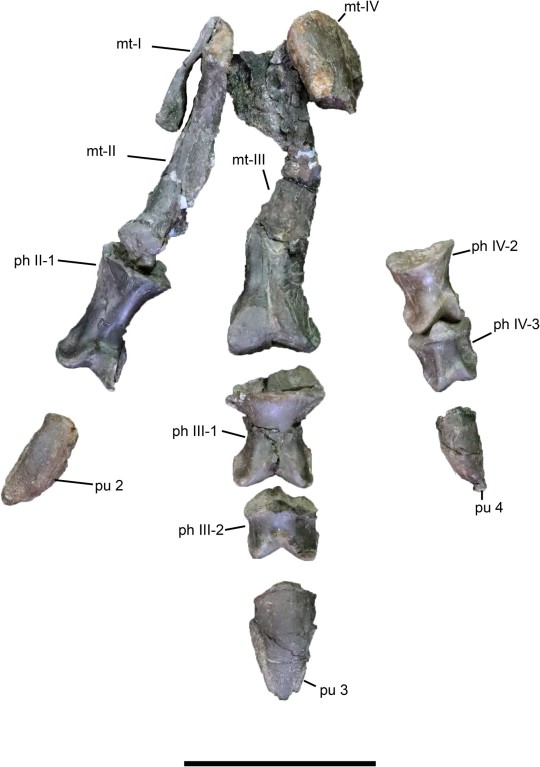
(Foot bones of Hesperonyx martinhotomasorum [scale bar = 10 cm], from Rotatori et al., 2024)
Meaning of name: Hesperonyx = western claw [in Greek]; martinhotomasorum = for Micael Martinho and Carla Alexandra Tomás [fossil preparators at the Museu da Lourinhã]
Age: Late Jurassic (Kimmeridgian)
Where found: Lourinhã Formation, Oeste, Portugal
How much is known: A partial left hindlimb and isolated forelimb bones of one individual.
Notes: Hesperonyx was an iguanodontian, a diverse group of plant-eating dinosaurs that includes the duck-billed hadrosaurids. It was relatively small for an iguanodontian, estimated as having been 3–4 m long in total body length. Although its overall proportions were fairly stout, its forelimb bones lack the adaptations for walking on all fours seen in many later iguanodontians, such as Iguanodon and hadrosaurids, and so it was likely a relatively agile, bipedal dinosaur.
Reference: Rotatori, F.M., L. Ferrari, C. Sequero, B. Camilo, O. Mateus, and M. Moreno-Azanza. 2024. An unexpected early-diverging iguanodontian dinosaur (Ornithischia, Ornithopoda) from the Upper Jurassic of Portugal. Journal of Vertebrate Paleontology advance online publication. doi: 10.1080/02724634.2024.2310066
67 notes
·
View notes
Text
Kickstarting the "Chokepoint Capitalism" audiobook

My next book is Chokepoint Capitalism, co-written with the brilliant copyright expert Rebecca Giblin: it’s an action-oriented investigation into how tech and entertainment monopolies have destroyed creators’ livelihoods, with detailed, shovel-ready plans to unrig creative labor markets and get artists paid.
http://www.beacon.org/Chokepoint-Capitalism-P1856.aspx
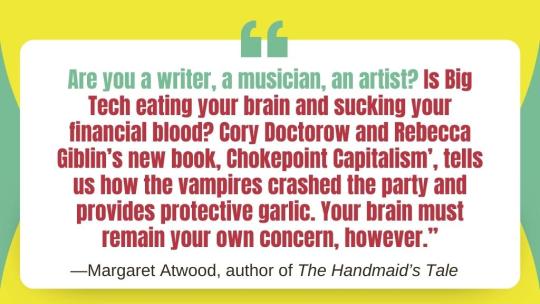
Ironically, the very phenomenon this book describes — “chokepoint capitalism” — is endemic to book publishing, and in audiobook publishing, it’s in its terminal phase. There’s no way to market an audiobook to a mass audience without getting trapped in a chokepoint, which is why we’re kickstarting a direct-to-listener edition:
https://www.kickstarter.com/projects/doctorow/chokepoint-capitalism-an-audiobook-amazon-wont-sell
What is “chokepoint capitalism?” It’s when a multinational monopolist (or cartel) locks up audiences inside a system that they control, and uses that control to gouge artists, creating toll booths between creators and their audiences.
For example, take Audible: the Amazon division controls the vast majority of audiobook sales in the world — in some genres, they have a 90%+ market-share. Audible requires every seller — big publishers and self-publishers alike — to use their proprietary DRM as a condition of selling on the platform.
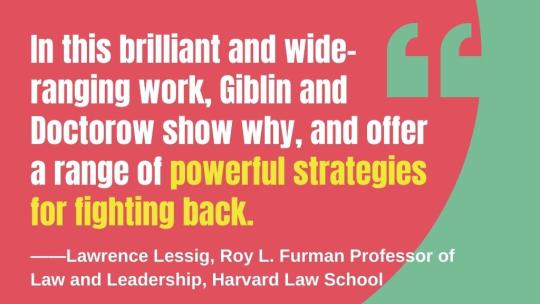
That’s a huge deal. DRM is useless at preventing copyright infringement (all of Audible’s titles can be downloaded for free from various shady corners of the internet), but it is wildly effective at locking in audiences and seizing power over creators. Under laws like the USA’s Digital Millennium Copyright Act, giving someone a tool to remove DRM is a felony, punishable by 5 years in prison and a $500k fine.
This means that when you sell your audiobooks on Audible, you lock them to Audible’s platform…forever. If another company offers you a better deal for your creative work and you switch, your audience can’t follow you to the new company without giving up all the audiobooks they’ve bought to date. That’s a lot to ask of listeners!

Amazon knows this: as their power over creators and publishers has grown, the company has turned the screw on them, starting with the most powerless group, the independent creators who rely on Amazon’s self-serve ACX system to publish their work.
In late 2020, a group of ACX authors discovered that Amazon had been systematically stealing their wages, to the tune of an estimated $100,000,000. The resulting Audiblegate scandal has only gotten worse since, and while the affected authors are fighting back, they’re hamstrung by Amazon’s other unfair practices, like forcing creators to accept binding arbitration waivers on their way through the chokepoint:
https://pluralistic.net/2020/11/03/somebody-will/#acx

I have always had a no-DRM policy for my ebooks and audiobooks. Amazon’s Kindle store — another wildly dominant part of the books ecosystem — has always allowed authors to choose whether or not to apply DRM, but in Audible — where Amazon had a commanding lead from the start, thanks to their anti-competitive acquisition of the formerly independent Audible company — it is mandatory.
Because Audible won’t carry my DRM-free audiobooks, audiobook publishers won’t pay for them. I don’t blame them — being locked out of the market where 90%+ of audiobooks are sold is a pretty severe limitation. For a decade now, I’ve produced my own audiobooks, using amazing narrators like @wilwheaton, Amber Benson and @neil-gaiman.

These had sold modestly-but-well, recouping my cash outlays to fairly compensate the readers, directors and engineers involved, but they were still niche products, sold at independent outlets like Libro.fm, Downpour, and my own online storefront:
https://craphound.com/shop

But that all changed in 2020, with the publication of Attack Surface, an adult standalone novel set in the world of my bestselling YA series Little Brother. That time, I decided to use Kickstarter to pre-sell the audio- and ebooks and see if my readers would help me show other creators that we could stand up to Audible’s bullying.
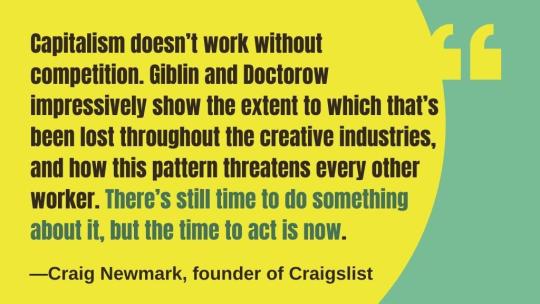
Holy shit, did it ever work. The Kickstarter for the Attack Surface audiobook turned into the most successful audiobook crowdfunding campaign in world history, grossing over $267,000:
https://www.kickstarter.com/projects/doctorow/attack-surface-audiobook-for-the-third-little-brother-book
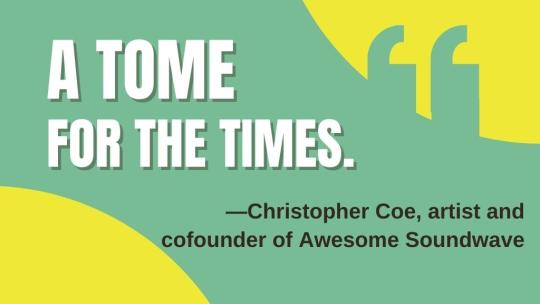
Which brings me to today, and our new Kickstarter for Chokepoint Capitalism. We produced an independent audiobook, tapping the incomparable Stefan Rudnicki (winner of uncountable awards, narrator of 1000+ books, including Ender’s Game) to read it.
We’re preselling the audiobook ($20), ebook ($15), hardcover ($27), and bundles mixing and matching all three (there’s also bulk discounts). There’s also the option to buy copies that we’ll donate to libraries on your behalf. We’ve got pins and stickers — and, for five lucky high-rollers, we’ve got a very special artwork called: “The Annotated Robert Bork.”
https://www.kickstarter.com/projects/doctorow/chokepoint-capitalism-an-audiobook-amazon-wont-sell

Robert Bork was the far-right extremist who convinced Ronald Reagan to dismantle antitrust protection in America, and then exported the idea to the rest of the world (Reagan tried to reward him with a Supreme Court seat, but Bork’s had been Nixon’s Solicitor General and his complicity in Nixon’s crimes cost him the confirmation).
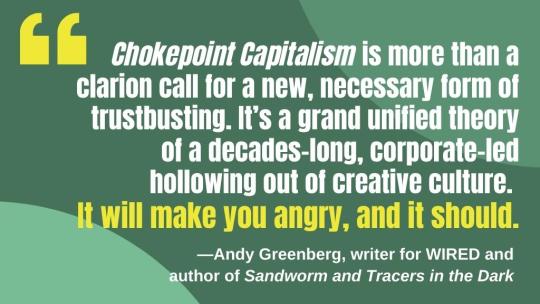
Bork’s dangerous antitrust nonsense destroyed the world as we knew it, giving us the monopolies that have wrecked the climate, labor protections and political integrity. These monopolies have captured every sector of the economy — from beer and pro-wrestling to health insurance and finance:
https://www.openmarketsinstitute.org/learn/monopoly-by-the-numbers
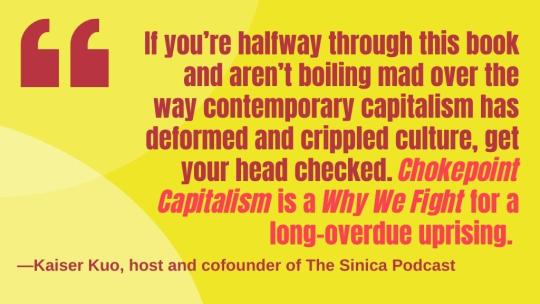
“The Annotated Robert Bork” is a series of five shadow-boxes containing two-page spreads excised from Bork’s 1978 pro-monopoly manifesto
The Antitrust Paradox
, which we have mounted on stiff card and hand-annotated with our red pens. The resulting package is a marvel of museum glass and snark.
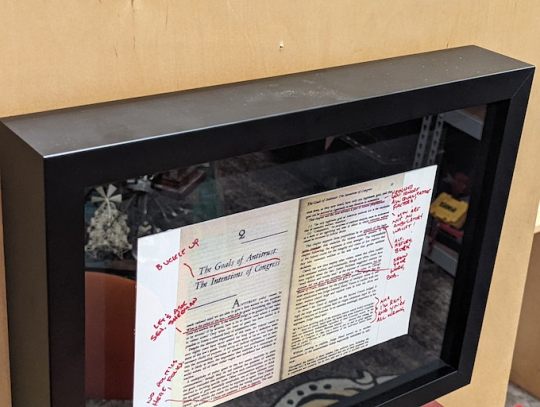
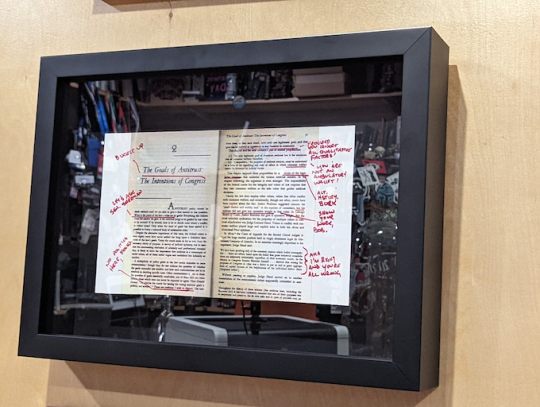
[Image ID: A prototype of ‘The Annotated Robert Bork]
Bork’s legacy is monopolistic markets in every sector of the world’s economy, including the creative industries. Chokepoint Capitalism systematically explores how tech and entertainment giants have rigged music streaming, newspapers, book publishing, the film industry, TV, video streaming, and others, steadily eroding creators’ wages even as their work generated more money for the monopolists’ shareholders.
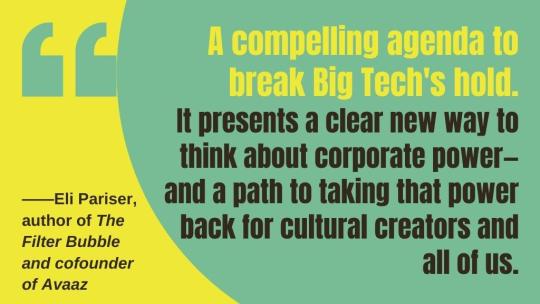
But just as importantly, our book proposes things we can do right now to unrig creative labor markets. Drawing on both existing, successful projects and promising new experiments, we set out shovel-ready ideas for creators, artists’ groups, fans, technologists, startups, and local, regional and national governments.
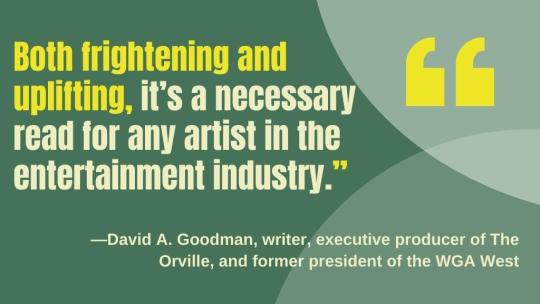
Artists aren’t in this struggle alone. As we write in the book, chokepoint capitalism is the final stage of high-tech capitalism, which atomizes workers and locks in customers and then fleeces workers as a condition of reaching their audiences. It’s a form of exploitation that is practiced wherever industries concentrate, which is why creators can’t succeed by rooting for Big Tech against Big Content or vice-versa.
It’s also why creative workers should be in solidarity with all workers — squint a little at Audible’s chokepoint shakedown and you’ll recognize the silhouette of the gig economy, from Uber to Doordash to the poultry and meat-packing industries.
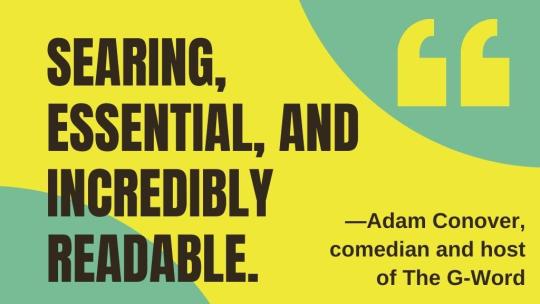
40 years of official pro-monopoly policy has brought the world to the brink of collapse, as monopoly profits and concentrated power allowed an ever-decreasing minority of the ultra-rich to extract ever-increasing fortunes from ever-more-precarious workers. It’s a flywheel: more monopoly creates more profits creates more power creates more monopoly.
The solutions we propose in Chokepoint Capitalism are specific to creative labor, but they’re also examples of the kinds of tactics that we can use in every industry, to brake the monopolists’ flywheel and start a new world.
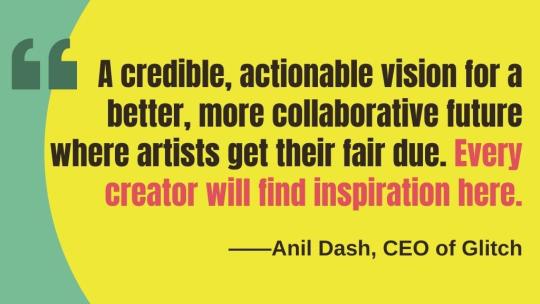
I hope you’ll consider backing the Kickstarter if you can afford to — and if you can’t, I hope you’ll check out one of the copies our backers have donated to libraries around the world:
https://www.kickstarter.com/projects/doctorow/chokepoint-capitalism-an-audiobook-amazon-wont-sell
[Image ID: An image of a mobile phone playing the Chokepoint Capitalism audiobook, along with the title and subtitle of the book: 'Chokepoint Capitalism: How Big Tech and Big Content Captured Creative Labor Markets and How We'll Win Them Back.']
[Image ID: Are you a writer, a musician, an artist? Is Big Tech eating your brain and sucking your financial blood? Cory Doctorow and Rebecca Giblin’s new book, Chokepoint Capitalism’, tells us how the vampires crashed the party and provides protective garlic. Your brain must remain your own concern, however.’ — Margaret Atwood, author of The Handmaid’s Tale]
[Image ID: I loved this book. It brings a clear and rigorous vision of the chokepoint controls that are breaking our spirit and an equally clear path forward. It speaks directly to creators, would-be artists, writers, and musicians, and all who want a free society alive with culture, dissent, creativity. It helps us all see the locks and chains, and the ways to chisel through them.’ — Zephyr Teachout, law professor and author of Corruption in America and Break ’Em Up]
[Image ID: Creators are being ground up by the modern culture industries, with little choice but to participate in markets that weaken their power and economic return. In this brilliant and wide-ranging work, Giblin and Doctorow show why, and offer a range of powerful strategies for fighting back.’ — Lawrence Lessig, Roy L. Furman Professor of Law and Leadership, Harvard Law School]
[Image ID: This compellingly readable indictment shows how ‘consumer welfare’ regulatory theory has allowed Big Tech to choke creators and diminish choice. Giblin and Doctorow demonstrate that the goal to lower consumer costs means ‘you get what you pay for’: paying less for cultural goods leads to getting fewer creative outputs and enterprises. Chokepoint Capitalism couples its legal-economic critique with provocative, sometimes utopian, prescriptions for fairly remunerating authors and performers.’ — Jane C. Ginsburg, Morton L. Janklow Professor of Literary and Artistic Property Law, Columbia University School of Law]
[Image ID: The great myth of the American economy is that it rewards creators and producers. But Chokepoint Capitalism dares to tell the real story of how it actually rewards the all-powerful middlemen fleecing both workers and consumers. This book is an absolute must-read for anyone who senses that the predominant economic mythology is a lie, who wants to know what’s really happening in this economy — and who is ready to finally start fixing the problem.’ — David Sirota, writer of Don’t Look Up and founder of The Lever]
[Image ID: We all know something is wrong about every click, stream, and purchase we make — unfairly depriving value creators of their worth, while enriching the wealthiest and most extractive entities in human history. Instead of just complaining about the corporate stranglehold over production and exchange, Giblin and Doctorow show us why this happened, how it works, and what we can do about it. An infuriating yet inspiring call to collective action.’
— Douglas Rushkoff, author of Throwing Rocks at the Google Bus and Survival of the Richest]
[Image ID: Twenty years of internet copyright wars got us nowhere — creators are still getting the shaft. Giblin and Doctorow persuasively argue that copyright can’t unrig a rigged market — for that you need worker power, antitrust, and solidarity.’ — Jimmy Wales, cofounder of Wikipedia]
[Image ID: Capitalism doesn’t work without competition. Giblin and Doctorow impressively show the extent to which that’s been lost throughout the creative industries, and how this pattern threatens every other worker. There’s still time to do something about it, but the time to act is now.’ — Craig Newmark, founder of Craigslist]
[Image ID: Chokepoint Capitalism really is a tome for the times. It’s comforting to feel validated and terrifying to realize I was right all along! And now, to action! The revolution will not be spotified!’ — Christopher Coe, artist and cofounder of Awesome Soundwave]
[Image ID: If you have ever wondered why the web feels increasingly stale, Chokepoint Capitalism outlines in great detail how it is being denied fresh air. Over the past two decades, we have seen an immense consolidation of power, depriving us of fresh visions for what the web could be and contorting art and culture to flatter the objectives of a few platforms. This book does a remarkable job of identifying the blockages and surfacing ideas on the margins that could reroute us. I’m grateful it exists!’ — Mat Dryhurst, artist and researcher, NYU’s Clive Davis Institute of Recorded Music]
[Image ID: Chokepoint Capitalism is more than a clarion call for a new, necessary form of trustbusting. It’s a grand unified theory of a decades-long, corporate-led hollowing out of creative culture. It will make you angry, and it should.’ — Andy Greenberg, writer for WIRED and author of Sandworm and Tracers in the Dark]
[Image ID: If you’re halfway through this book and aren’t boiling mad over the way contemporary capitalism has deformed and crippled culture, get your head checked. Chokepoint Capitalism is a Why We Fight for a long-overdue uprising. Rebecca Giblin and Cory Doctorow lay out their case in plain and powerful prose, offering a grand tour of the blighted cultural landscape and how our arts and artists have been chickenized, choked, and cheated. But it’s more than just a call to arms; it also provides a plan of battle with inspired strategy and actual tactics — ways that we can all channel that anger and make real change.’ — Kaiser Kuo, host and cofounder of The Sinica Podcast]
[Image ID: The story of how a few giant corporations are strangling the life out of our media ecosystem is one of the most important of the decade, and Giblin and Doctorow tell it better than anyone. Searing, essential, and incredibly readable.’ — Adam Conover, comedian and host of The G-Word]
[Image ID: Chokepoint Capitalism is not just a fascinating tour of the hidden mechanics of the platform era, from Spotify playlists to Prince’s name change, but a compelling agenda to break Big Tech’s hold. It presents a clear new way to think about corporate power — and a path to taking that power back for cultural creators and all of us.’ — Eli Pariser, author of The Filter Bubble and cofounder of Avaaz]
[Image ID: Chokepoint Capitalism is a masterwork. Rebecca Giblin and Cory Doctorow lay out in chilling detail how the deck is stacked against artists, the relentless corporate drives to control production and distribution through technology and deregulation, and how oligopolies deprive gifted artists of fair compensation by eliminating true competition. But they don’t stop there: this is also a useful handbook to take on that power structure. Giblin and Doctorow remind us that when individuals understand the value of their work, they can create the necessary leverage to challenge the status quo and retake what is rightfully theirs. Both frightening and uplifting, it’s a necessary read for any artist in the entertainment industry.’ — David A. Goodman, writer, executive producer of The Orville, and former president of the WGA Wes]
[Image ID: Anyone who cares about culture can see that something is deeply amiss in the ‘creator economy’ that today’s artists are obligated to participate in. Rather than simply lamenting the problem or falling back on clichés about starving artists, what Rebecca Giblin and Cory Doctorow do in Chokepoint Capitalism is to make clear the overall pattern that drives the exploitation of artists, from music to gaming to film to books. And they lay out a credible, actionable vision for a better, more collaborative future where artists get their fair due. Every creator will find inspiration here.’ — Anil Dash, CEO of Glitch]
#pluralistic#labor#creative labor markets#chokepoint capitalism#audible#monopolies#audiobooks#amazon#monopsonies#solidarity#crowdfunding#kickstarter#drm
2K notes
·
View notes